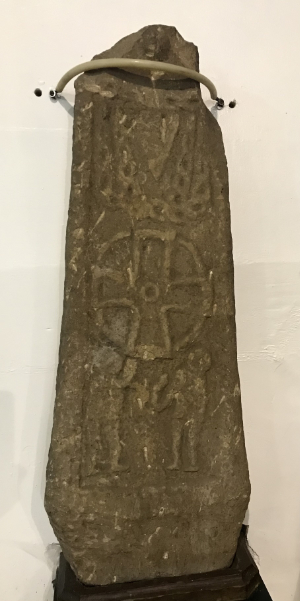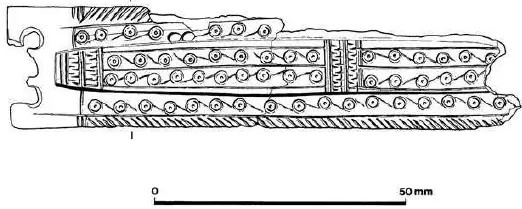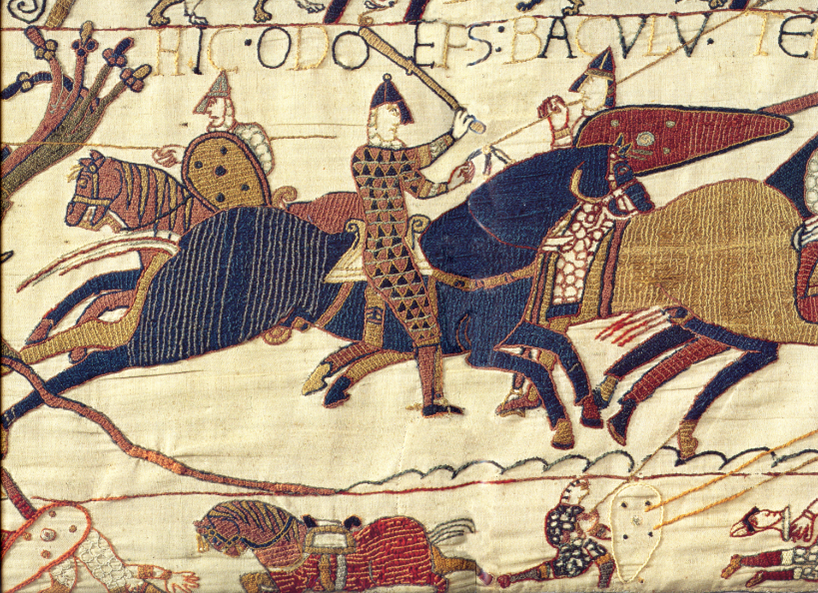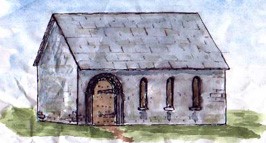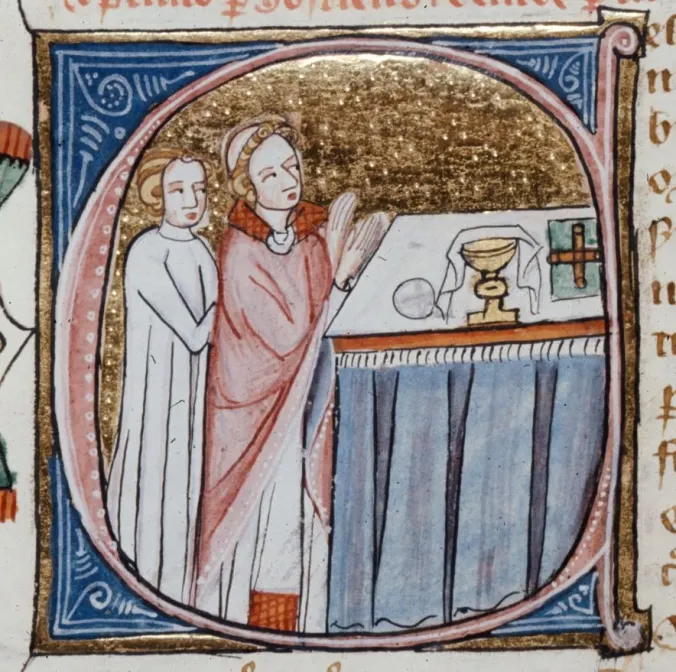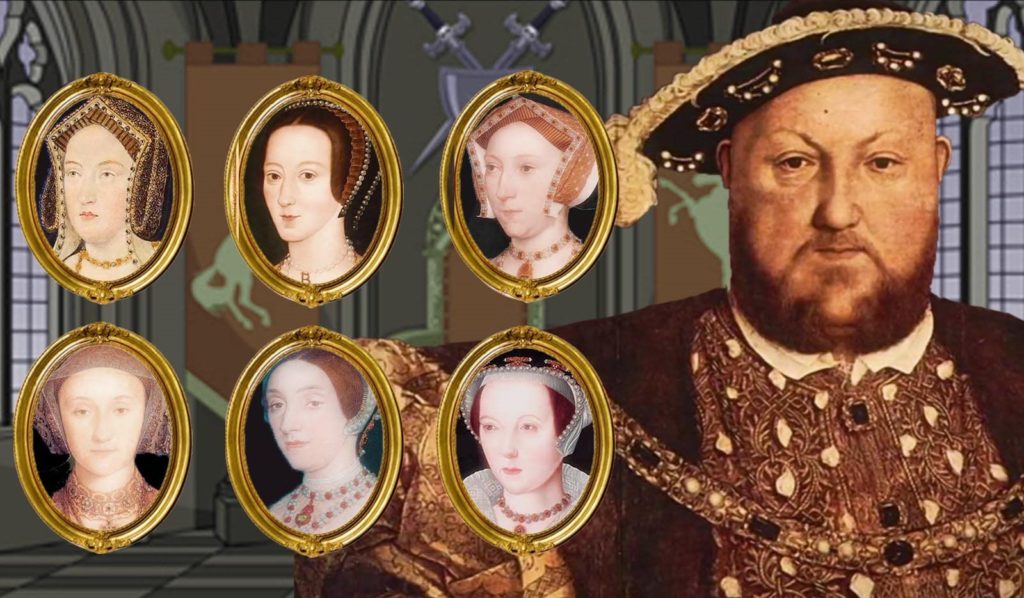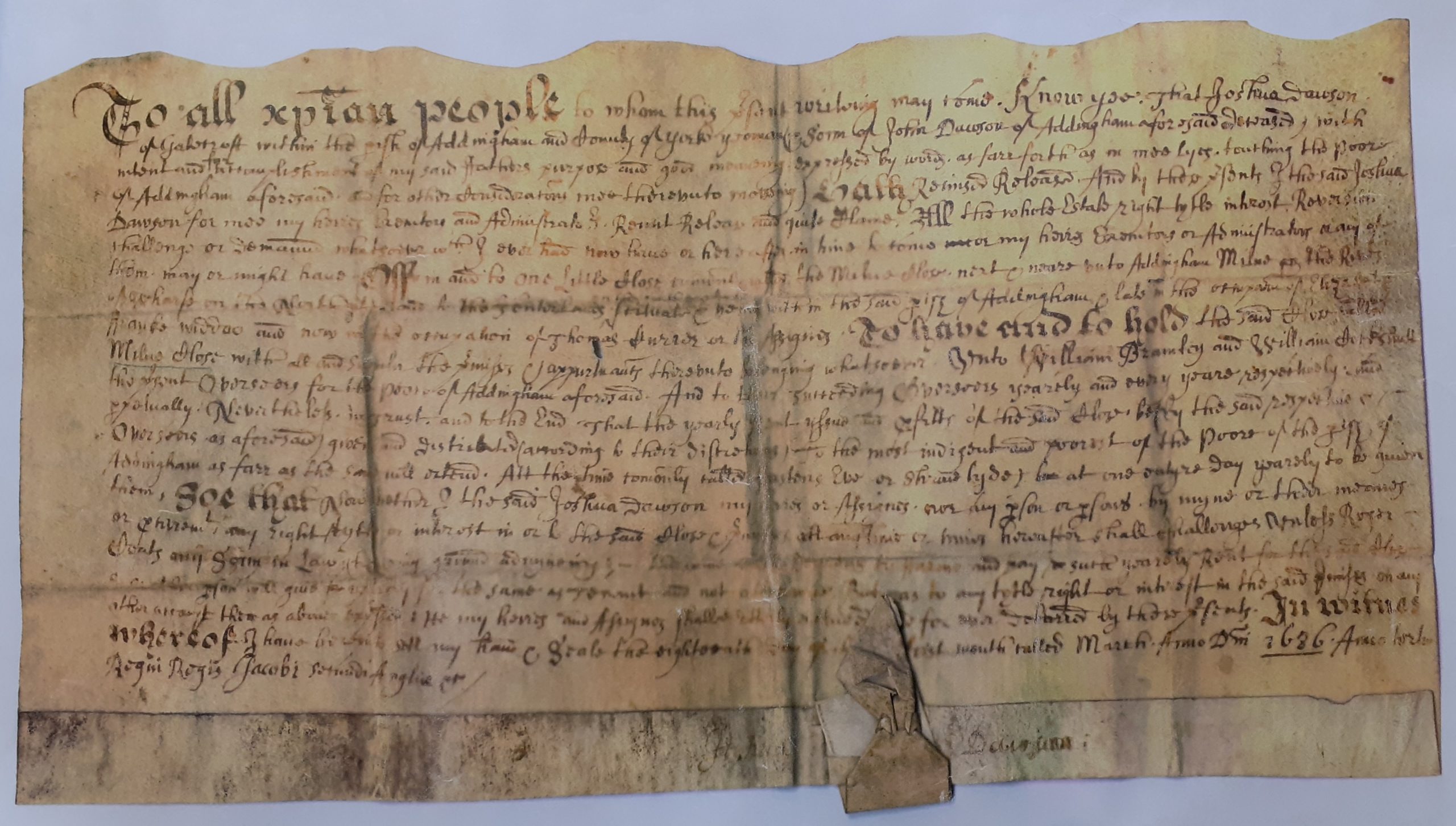Church History
Christians have worshipped in Addingham on this site in three millennia.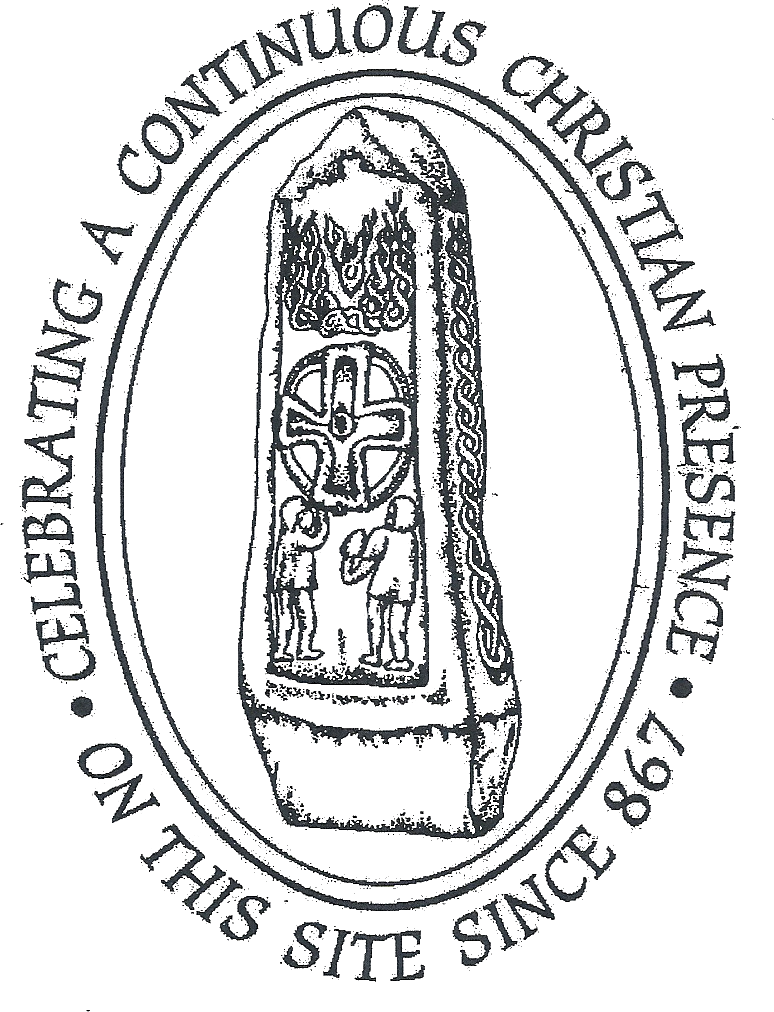
Here is a short video about the history of St. Peter’s church.
Our 2006-8 project celebrated the timeline of Christianity in Addingham.
9th Century
Our story begins in the year 867. Addingham lay within the Anglian kingdom known as Northumbria, and at that time the Archbishop of York was named Wulfhere. Archbishops were powerful men, part of the Witan giving counsel to the King. Like the king, they were able to issue coinage.

In 867, the Danes captured York and, according to the Anglo Saxon Chronicles, “there was immeasurable slaughter among the Northumbrians.” (Yorkshire was then part of the Kingdom of Northumbria). Archbishop Wulfhere fled the city.
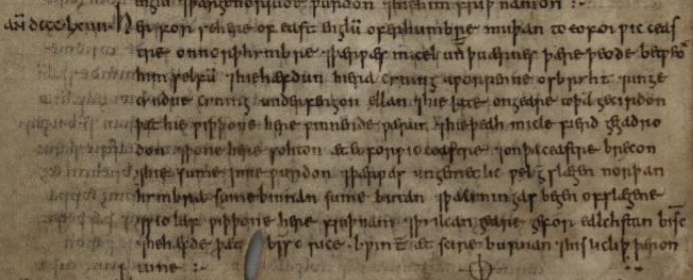
Extract for the year 867 from the Parker Chronicle, the oldest of the four main manuscripts of the Anglo Saxon Chronicles. It was probably started at Winchester and taken to Christchurch, Canterbury some time after the Norman Conquest. The Chronicles are unusual in that they are not written in Latin but in Old English (Anglo Saxon). This extract shows why Archbishop Wulfhere fled York and came to Addingham; its translation reads:
“AD 867. The army went from East Anglia over the Humber’s mouth to York in Northumbria. There was great discord in this people amongst themselves; they had overthrown their king, Osbriht, and had taken an unnatural king, Aelle. They decided late in the year that they were going to fight the others, yet they gathered a great army and sought the force* at York, they broke into the fort; some went in and there was immeasurable slaughter among the Northumbrians, some inside and some outside. The kings were both killed, and the survivors made peace with the force. The same year, bishop Ealhstan died; he had the bishoric at Sherbourne for fifty years, and his body lies there in the churchyard.”
(*The Viking army is often referred to in the Chronicles as “the force”.)
Symeon, an 11th century monk of Durham Abbey tells that “while these bloody struggles were going on, Bishop Wulfhere kept aloof, residing at Hatyngham, a valley in the Western part of Yorkshire which is called Hwerverdale, upon the bank of the River Hwerf between Otley and the Castle of Sciptun”.
There must have been a well established Christian community already here although the Church was of people and not a building.
Worship in those days took place around a carved stone cross. The remains of Addingham’s cross were discovered in 1947.
Anglo Saxon cross shaft
A dig in the 1970’s discovered a carved bone fragment, possibly a comb case, dating from this time. During excavations in 1990 prior to building extensions to the Church Hall, many Anglo-Saxon burials were uncovered dating from at least a hundred years before the arrival of Wulfhere.
image drawn by Chris Philo, from article by Max Adams
Wulfhere remained in Addingham until about 875 when he was recalled to York by Guthred, the then Christian Danish ruler of the city.
He remained in York until his death in the year 900.
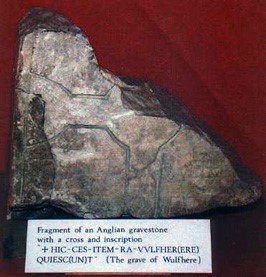
This Anglian gravestone, carved with a cross and words identifying the grave of Wulfhere, is in the undercroft of York Minster. (It is not known whether it is the gravestone of Archbishop Wulfhere himself)
10th Century
924 Athelstan, grandson of Alfred the Great, becomes the first King of England.
Viking raids continued and when Ethelred II came to the throne in 978, the Viking armies he faced were fearsome and well organised. As the Danish raiders overpowered more and more land and towns, so they began to settle and by the end of the century they occupied much of Northumbria, East Anglia and the Midlands. They imposed their own laws on these areas and the occupied land became known as the Danelaw.
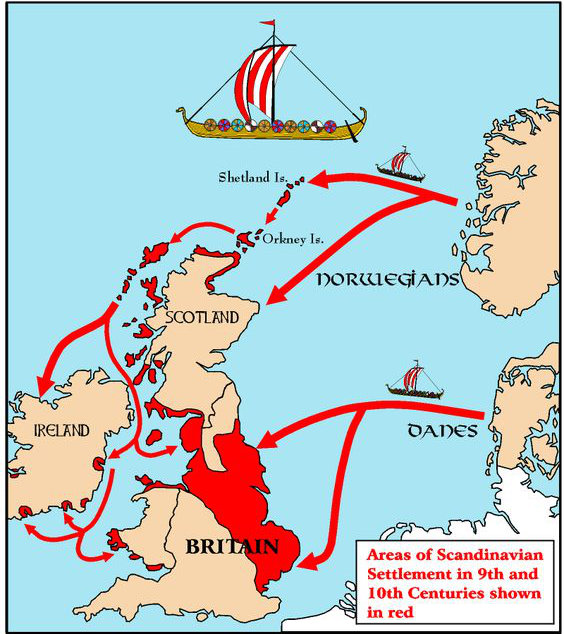
Little is known about Addingham during this time. Christian worship would have continued around the stone cross. It is very probable that the community suffered due to the Danish attacks.

Saxon bishop and priest
11th Century
1000
Ethelred II, in order to retain peace, imposed a tax on all the people in order to buy off the Danes. This was the infamous Danegeld. As the Danes were paid, so they demanded more and more. In 991 he had paid 22,000 pounds weight of gold and silver and in 1012 he paid 48,000 pounds weight. When the Dane Canute became King, he saw no reason to stop bleeding England of her silver. In 1017 he took 10,500 pounds weight from the people of London and 72,000 pounds weight from the rest of England. The result is that more Anglo-Saxon coins have been found in Denmark than in England.
1066 The Norman Conquest
A scene from the Bayeux Tapestry shows Bishop Odo rallying the troops of William the Conqueror during the Battle of Hastings
This brought about the most drastic social upheaval yet by an invader and conqueror. Here in Addingham, in place of the previous Anglo Saxon lord Gamelbar, Gilbert Tison (a follower of William the Conquerer) was given the lordship of Addingham, to be followed for several centuries by the Vavasours.
The transfer of power from Gamelbar is evidenced here
In 1069 the north of England rebelled and William’s ruthless and efficient military machine crushed the rebellion and laid waste the whole country north of the Humber. This is known as the Harrying of the North: villages were razed to the ground, inhabitants slain, livestock slaughtered and stores of food destroyed, so that people were reduced to eating cats and dogs; up to 150,000 people died as a result. It took ten years for the north to begin to recover.
1086 Domesday Book
William needed to find out the wealth of his kingdom in order to extract the maximum in taxation. He ordered a great survey to be carried out, the result of which was the Domesday Book. In the survey, Ilkley, Otley and Kildwick are shown to have a church and priest but the entry for Addingham mentions neither so we can assume that, as yet, no church building existed here.
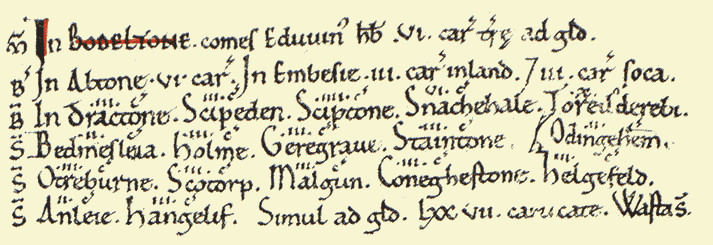
Entry for Addingham in Domesday book (in Domesday, Addingham is recorded variously as Edidham, Ediham, Odingehem and Odingehen)
12th Century
RECTORS
- 1189 Thomas
Soon after the Domesday survey, the King granted Addingham and Draughton to the de Romilles of Skipton and to the Percy family. The two families granted their share of Addingham to the Vavasours who held Addingham as owners and Lords of the Manor. They did not relinquish all their interest until 1715.
The seat of the Vavasour family was at Hazlewood, near Tadcaster, on Percy land. It is doubtful if any of the family lived here at this time, but a manor house was eventually built and some of the early members of the family must have lived at the manor as various deeds were signed here. In 1166 the manor was held by Sir William le Vavasour who was a King’s Justice and an important figure in northern life.
It is almost certain that it is to Sir William le Vavasour that we owe the first Church building. We know that Addingham had a Parson in 1189 because one Thomas, Parson of Addingham was a witness to a deed of a grant of land to Salley Abbey (an abbey of Cistercian monks in the village of Sawley, Lancashire, which was historically in the West Riding of Yorkshire) and also witnessed a grant by Hugo de Leathley to Bolton Priory.
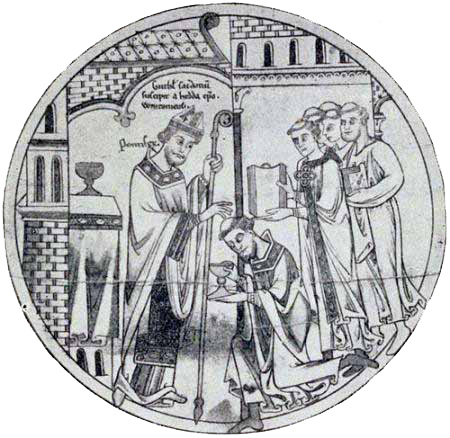
Ordination of a priest, 12th Century
There are no records to tell us what this first Church building was like, but it is probable that it was small, had no tower and had narrow, slit windows with no glass. We now know that it had a typical Norman arched doorway with zig-zag carvings because stone from this church was used to build the tower and zig-zag door carvings were found during recent renovations. (There is more information about the Norman stonework at St Peter’s here.)
The first church building probably looked something like this.
13th Century
RECTORS
- 1279 John Chatterton
- Thomas Stokyld
Apart from the names of two Rectors, little is known about the church during this century. As there are no records of any alterations or rebuilding, we can assume that worship carried on in the original Norman church.
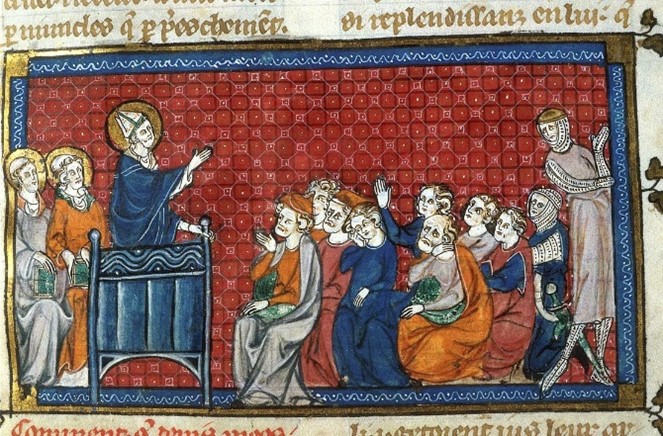
About the year 1205, Sir Robert Vavasour obtained permission from King John to make a park in Addingham and to hunt game.
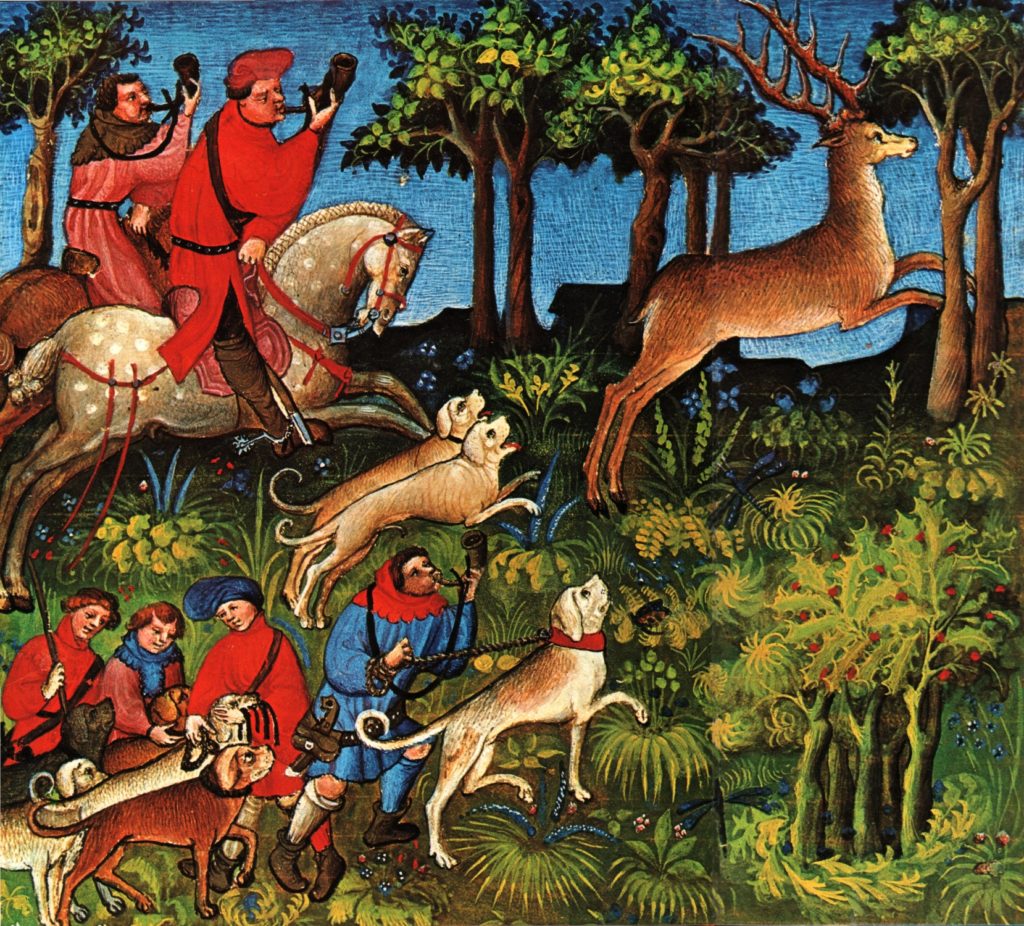
1215 Due to the insistent demands of the barons, King John sealed the Magna Carta on 15th June.
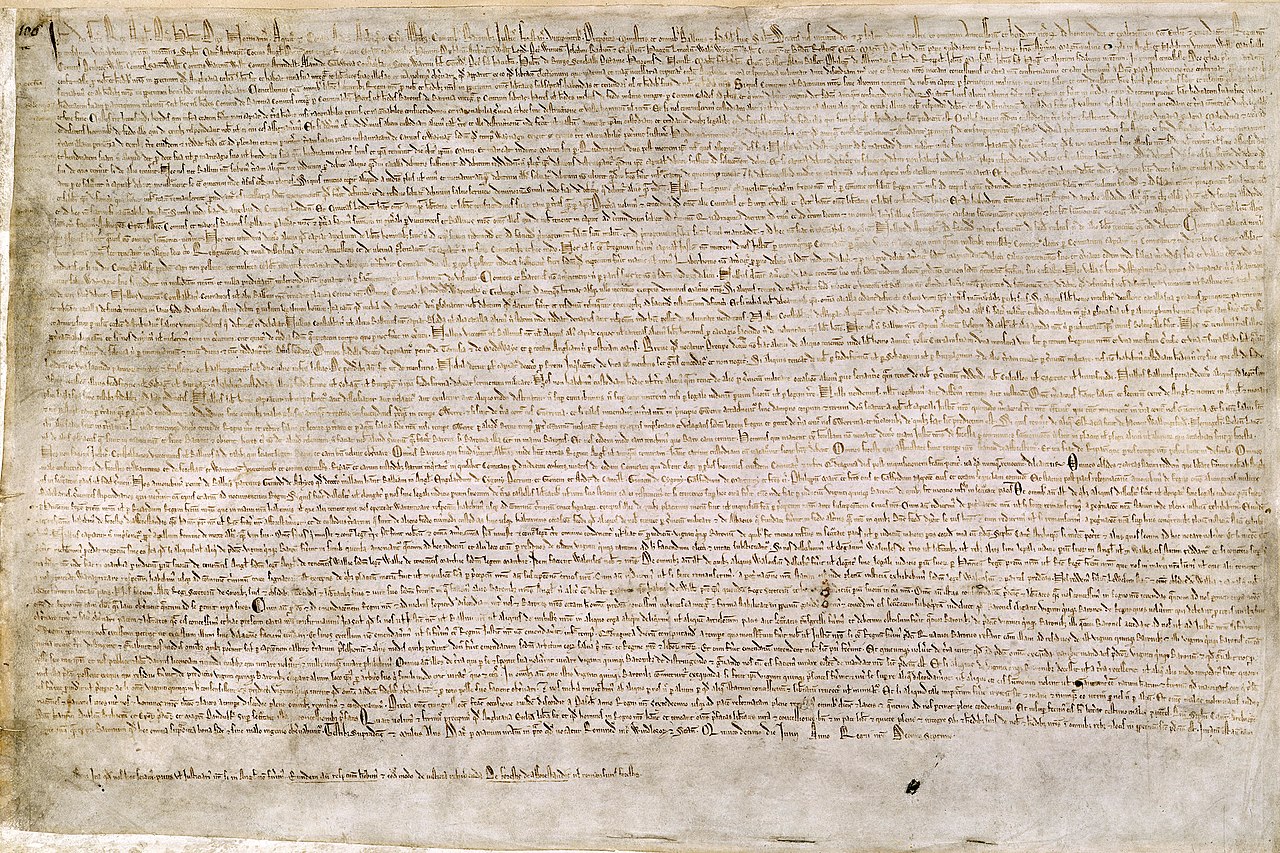
MAGNA CARTA
The Magna Carta laid down what the barons took to be the recognised and fundamental principles for the government of the Kingdom and bound the King and barons to maintain them. Its main provisions were that no man should be punished without fair trial, that ancient liberties generally should be preserved, and that no demands, other than those recognised, should be made by an overlord to his vassal without the sanction of the great council of the realm.
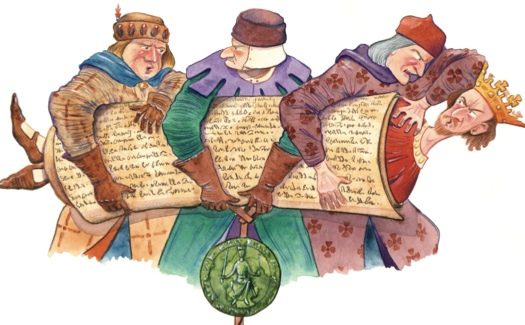
The records of York Minster show that in 1233-4, Robert le Vavasour granted to the Dean and Chapter rights to use his quarry at Thevesdale near Tadcaster to obtain stone for the Minster, along with free passage over his land for that purpose. Stone from this quarry continued to be supplied to the Minster until 1423. (The stone used to maintain the Minster is predominantly magnesian limestone, which is relatively rare in the UK, with the only seam running from County Durham down towards Nottinghamshire. The earliest documentary evidence for Minster’s use of the stone from the Tadcaster area is in 1184-9, and the Minster still sources stone from there today.)
14th Century
RECTORS
- 1341 Robert de Syderington
- 1349 William de Walthew
- 1352 Thomas Burgham
- 1353 Robert de Walsley
- William Loundres
- 1371 John Skayf
- 1383 Thomas de Eston
- Robert Pokelyngton
A good man was there of religioun,
And was a povre PERSON of a town –
But rich he was of holy thought and werk.
He was also a lerned man, a clerk,
That Christes gospel trewly wolde preche.
His parishens devoutly wold he teche.
Benign he was, and wonder diligent,
And in adversitee full pacient, ——–
Wide was his parish, and houses fer asunder,
But he ne lafte nought for rain ne thunder,
In sickness nor in meschief, to visite
The ferrest in his parish, much and lite,
Upon his feet, and in his hand a staff. —–
To drawen folk to heven by fairnesse,
By good ensample – this was his bisinesse. —-
A better preest I trow there nowhere none is!
He waited after no pomp and reverence,
Ne maked him a spiced concience,
But Christes lore and his apostles twelve
He taught-but first he followed it himselve.
In 1305, the manor and advowson (patronage) of the church was in the hands of John de Rythre. He had married Alionora, the widow of Sir Walter Vavasour. He was granted the right of free warren (the right to hunt) in 1318 and in 1323 he became Constable of Skipton Castle. On his death, the manor and patronage reverted to the Vavasours.
Another Sir William Vavasour again gave stone from his quarries in Thevesdale for the rebuilding of the nave of York Minster which was completed in 1360.

The Arms of Vavasour (or, a fess dancetty, sable)
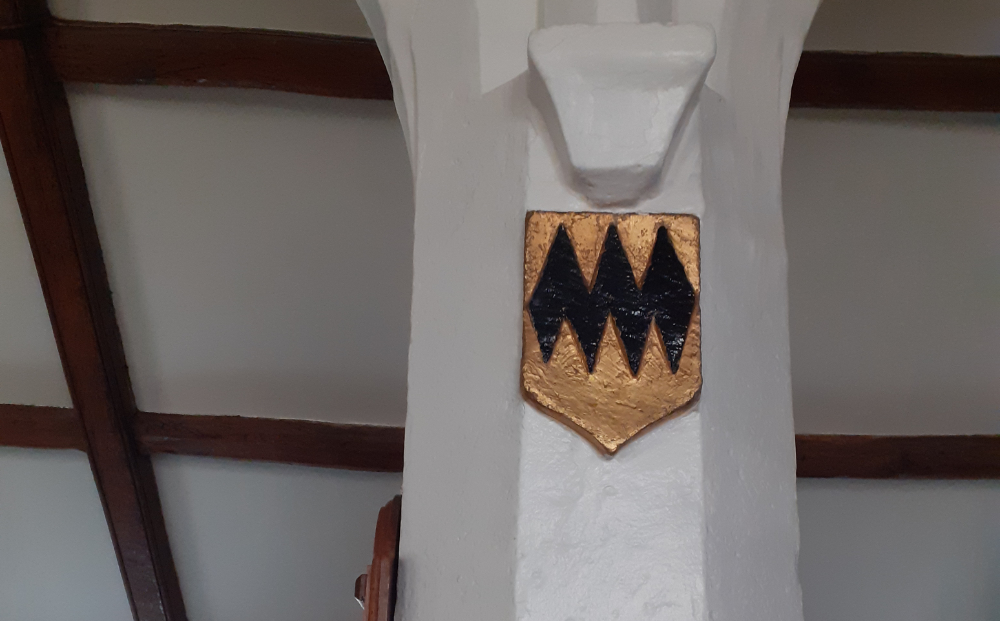
The arms displayed on the pillar in the nave are incorrect as they do not conform to the rules of heraldry. The fess dancetty (the zig-zag) should be contained in the middle third of the shield.
THE BLACK DEATH
The plague known as the ‘Black Death’ arrived in England in 1348 and spread rapidly throughout the kingdom. By 1350 it had killed thousands of people.
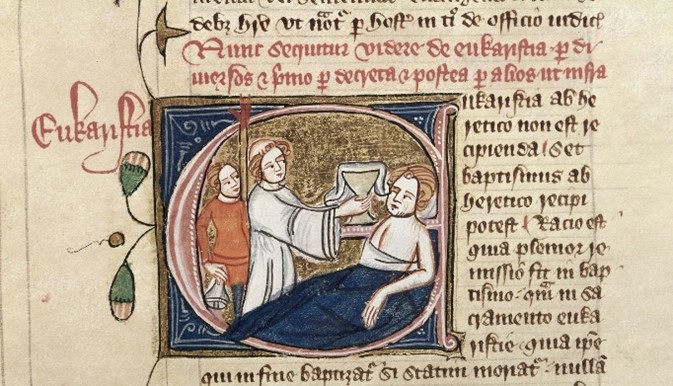
Priest gives communion to dying
The clergy were worst hit as they ministered to the sick and dying. We are told that a Rector of Addingham was a victim, the most likely being William de Walthew.
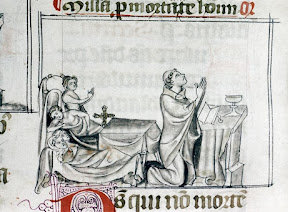
Priest ministering to the sick, from illuminated text of “Mass to be said in times of pestilence”
When the excavations for the hall extension uncovered graves, it was first thought that they may have been plague victims.
The symptoms of plague were boils, which could be the size of an apple, in the groin, armpits or neck and black spots on the skin. It is said that those who spat blood died in three days and the rest in five!
In London, two huge new cemeteries were created outside the city walls and an inscription read:
“A great plague raging in the year of our Lord 1349, this churchyard was consecrated; wherein..were buried more than fifty thousand bodies of the dead..whose souls God have mercy upon. Amen.”
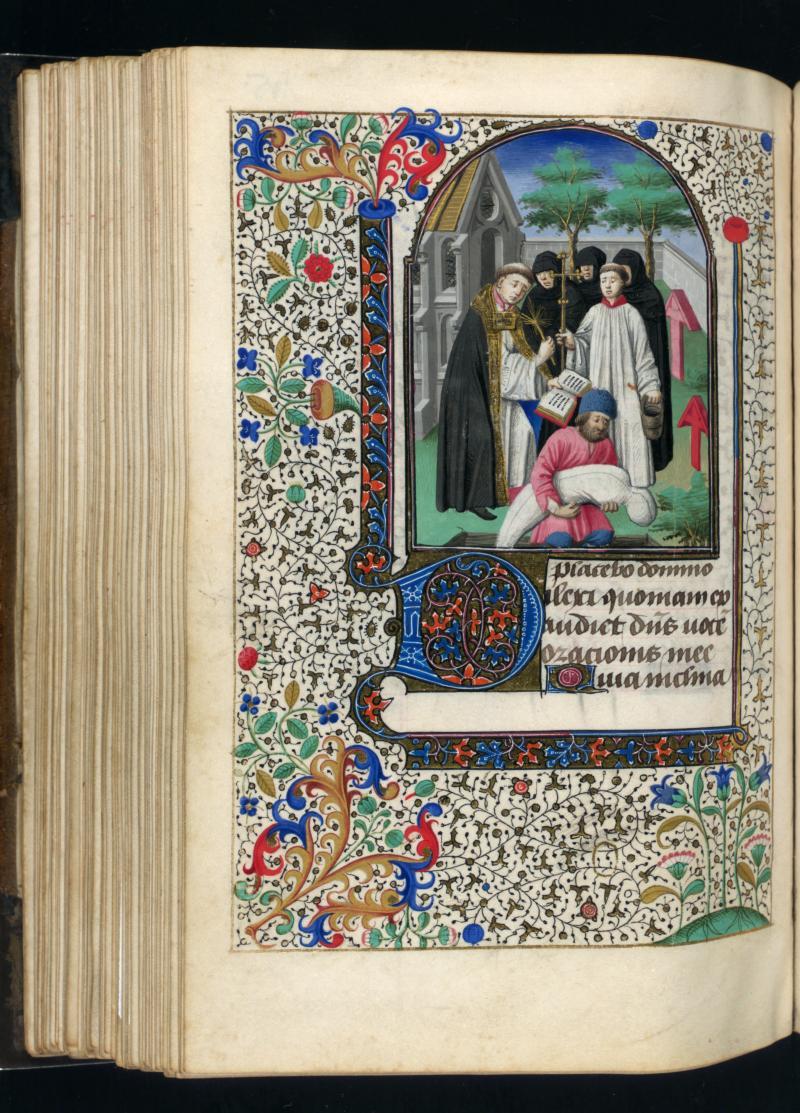
Funeral of a plague victim
A contemporary chronicler wrote:
“After the pestilence many buildings both great and small in all cities, towns and boroughs fell into total ruin for lack of inhabitants; similarly many villages and hamlets became desolate and no houses were left in them, for all those who dwelt in them were dead, and it seemed likely that many such little villages would never again be inhabited.”
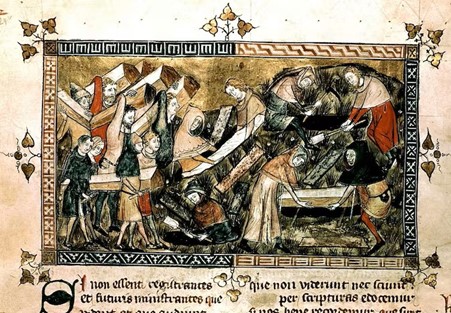
Plague burials
During the Middle Ages it was a legal requirement for all men to regularly practice archery with the longbow. Practice usually took place once a week in the churchyard and stones with long grooves in, where arrows were sharpened, can be found in some churches. It is safe to assume that practice at the butts regularly took place here at St Peter’s.
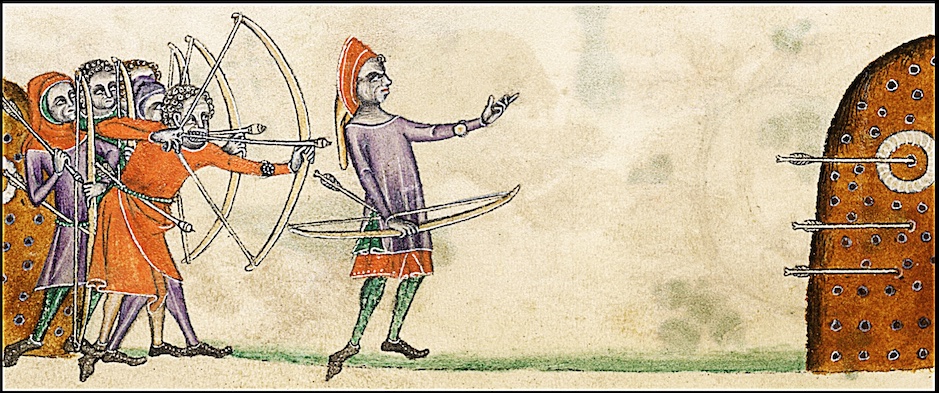
Archery practice, circa 1340
It was such practice that enabled the English bowmen to inflict devastation on the French armies at Crecy in 1346, Poitiers in 1356 and Agincourt in 1415 during the Hundred Years War.
15th Century
- 1414 William Blase
- 1446 William Milford
- 1449 Richard More
- Thomas Langton
- 1483 Leonard Vavasour
At the beginning of the 15th century, the Vavasours founded two Chantries at Hazlewood, one of St. Nicholas and the other of St. Mary (a chantry was a chapel founded for the Mass to be chanted for the soul of the founder). Priests from these Chantries were rewarded for their services by the gift of the living of Addingham. William Blasé, priest of the Chantry of St. Nicholas in 1412, became Rector of Addingham in 1414. Richard More, priest at the Hazlewood Chantries in 1443 became Rector in 1449 to be followed in due course by his successor at Hazlewood, Thomas Langton.
Towards the end of the century, Sir Henry Vavasour was Lord of the Manor, and his son Leonard became Rector in 1483. During his incumbency, the old Norman church, which had stood for three hundred years, was replaced by a new church, built in the late perpendicular style.
Of that church, the north aisle, the arcade of four arches, the chancel arch and the magnificent oak roof remain and are the most ancient parts of the present structure.
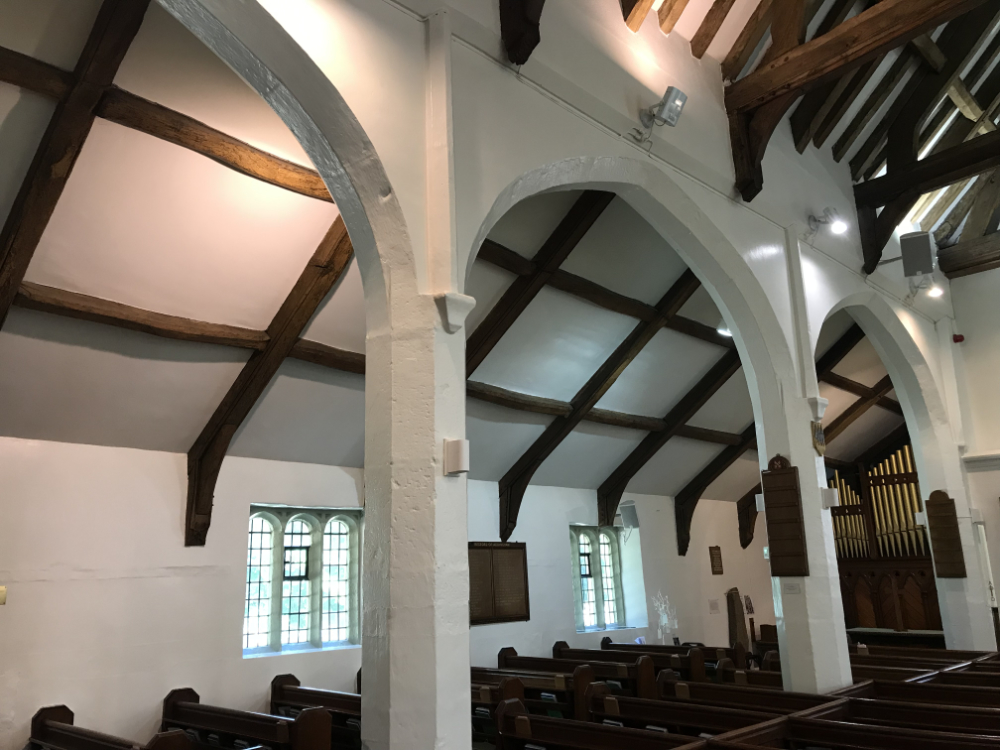
North Aisle

Arcade of arches
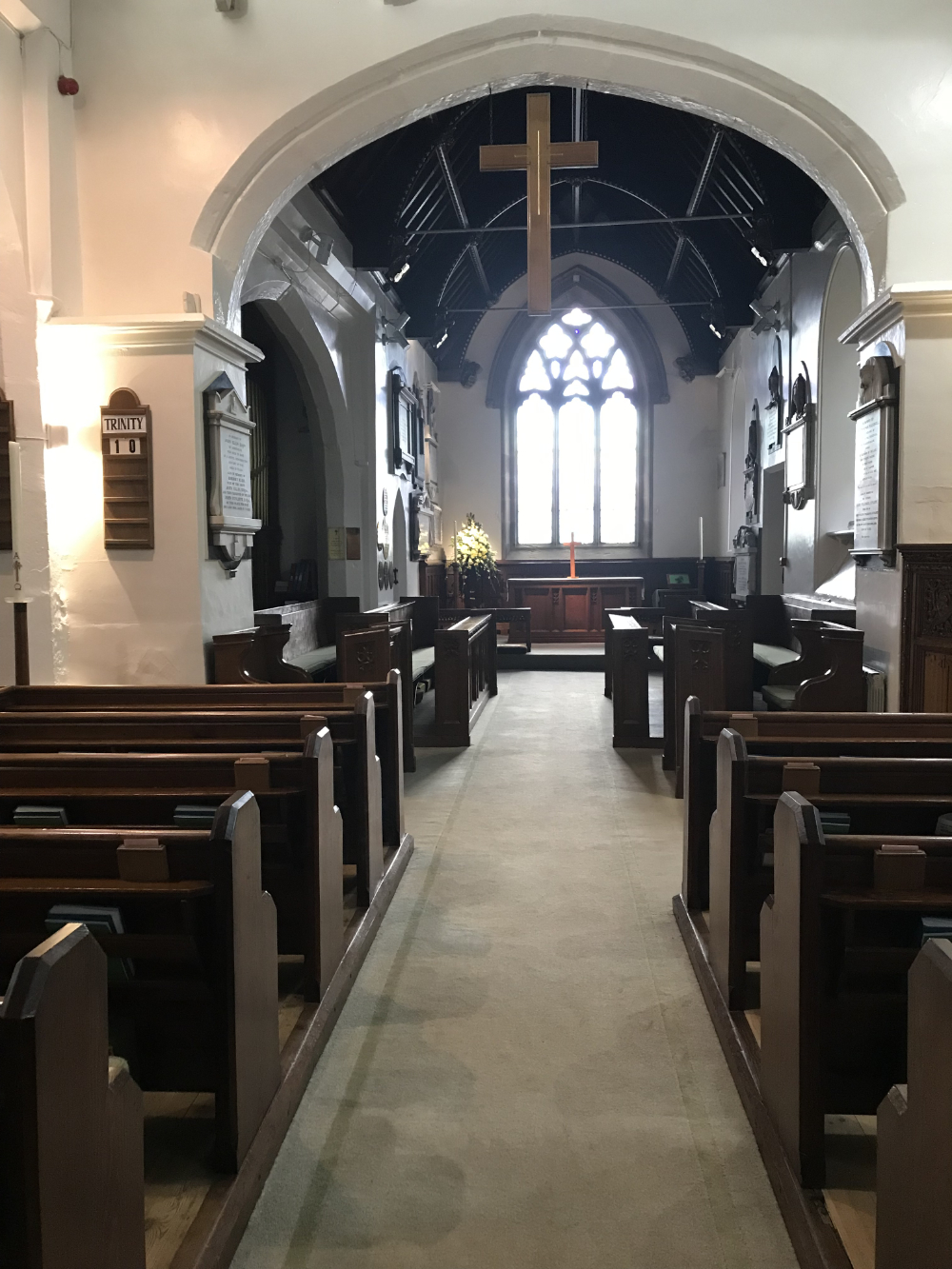
Chancel arch
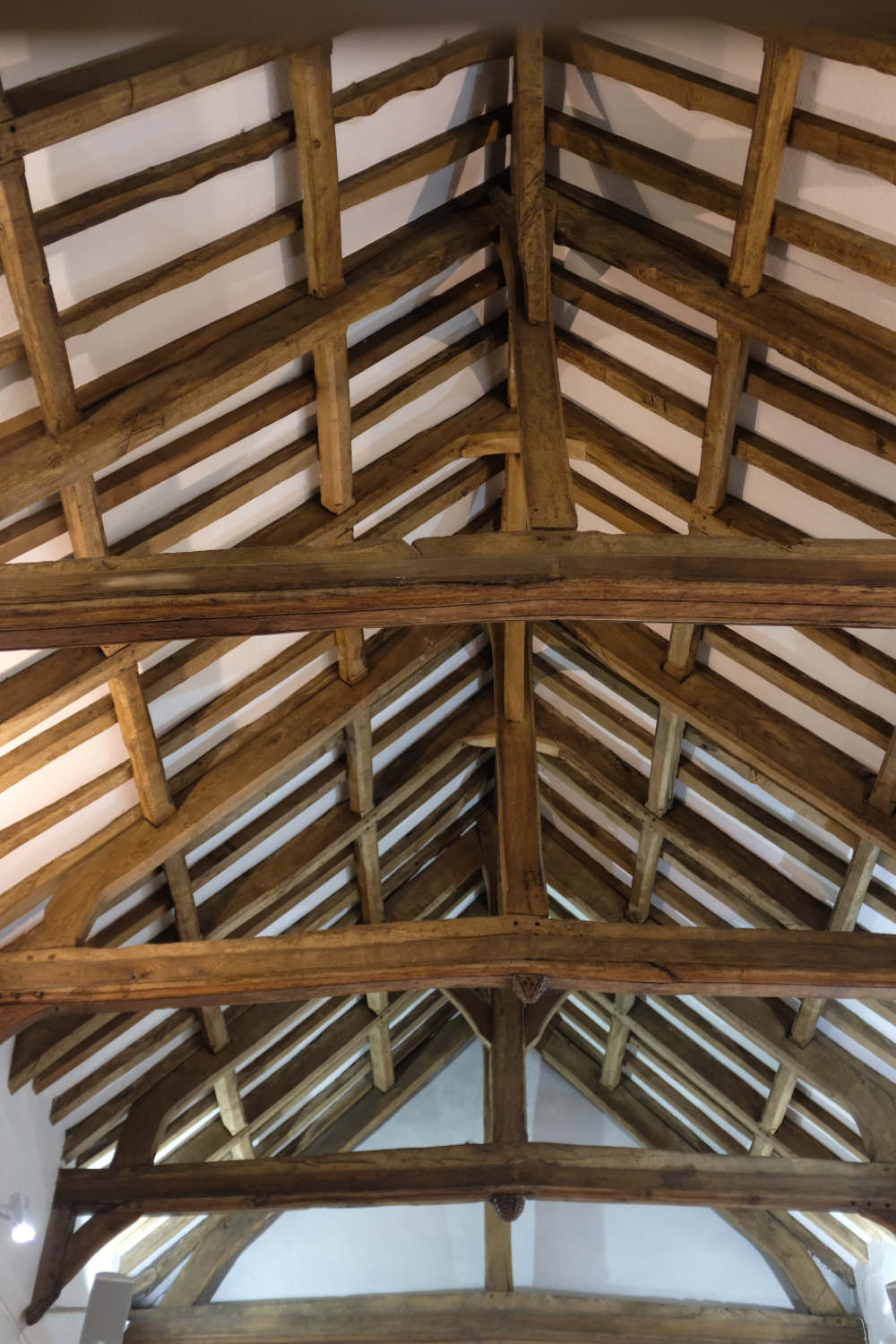
Nave roofbeams
Dendro–dating carried out in 2006 has revealed that the timbers in the North Aisle were likely to have been felled between 1511 and 1531, and that the Nave roof timbers were probably first used in the late 15th or early 16th centuries.
16th Century
RECTORS
- 1510 William Hardwick
- 1545 John Medhope
- 1572 Henry More
- 1590 Roger Wetherall
The 16th century brought about an enormous religious upheaval known as The Reformation. This started in Germany in 1517 when Martin Luther drew up his Ninety-five Theses. In 1521 Luther was excommunicated and the Protestant Reformation began to spread throughout Europe. In England, Henry VIII was in dispute with the Pope over his marriage to Catherine of Aragon which was declared null in 1533.
King Henry VIII and his six wives
The following year saw the Act of Supremacy when Henry VIII separated from the Roman Catholic Church and asserted control over the English Church. Thus began the Church of England.
In 1536 Henry began the dissolution of the monasteries and there was a rising in the North due to religious grievances.
William Hardwick who was Rector between 1510 and 1545 became the last Roman Catholic priest and the first Church of England priest although the old Latin service would still have been used until the introduction of the first English Prayer Book in 1549.
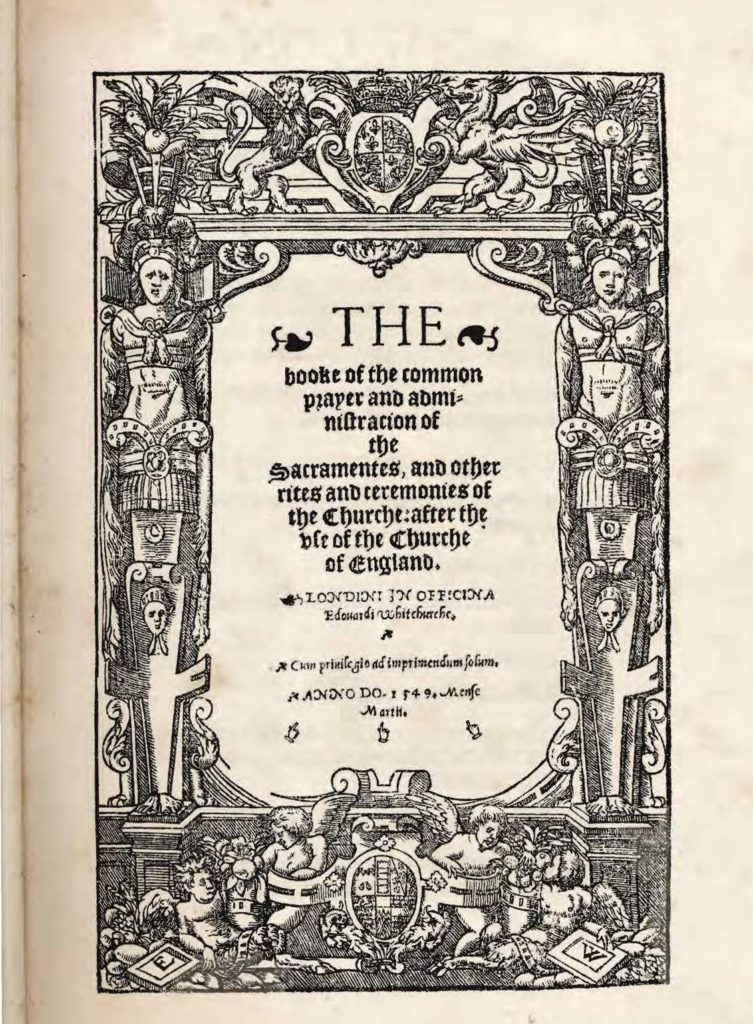
First English Prayer Book, 1549
17th Century
- 1611 William Webster
- 1658 Thomas Boyer
- 1665 Alex Kippax
- 1674 William Coultherst
- 1679 Henry Wright
In 1611 the Authorised Version of the Bible was published.
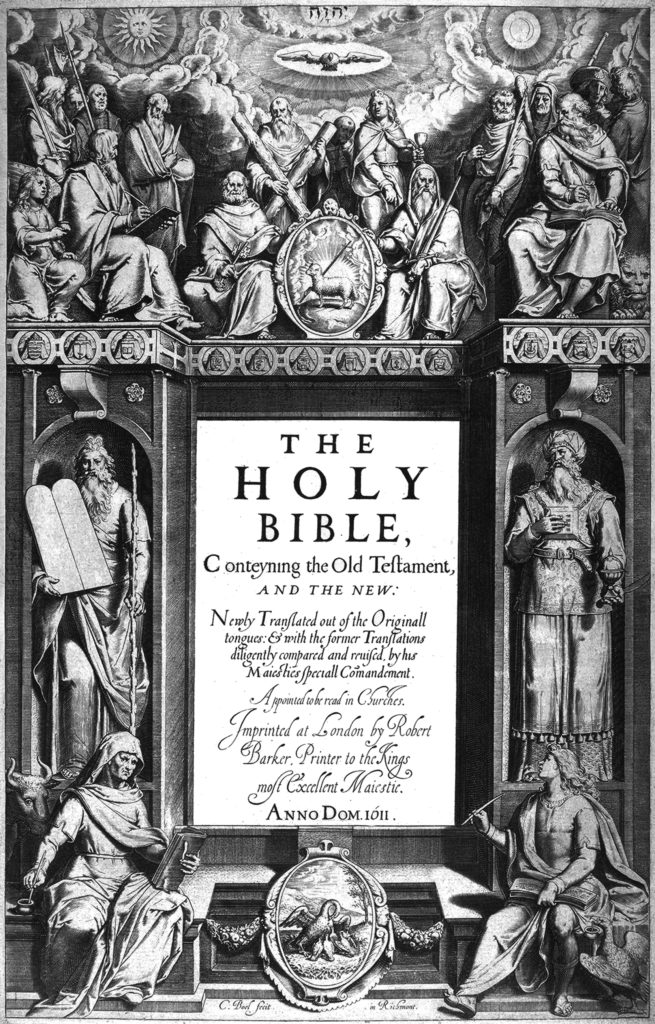
The Authorised (King James) Version of the Bible, 1611
This same year saw a new Rector, William Webster, inducted to the living. The following year, 1612, saw the beginning of the Parish Registers, giving details of baptisms, weddings and burials. William Webster was Rector for 47 years during eventful times in England, not the least being the English Civil War which began in 1642, the execution of Charles I in 1649 and the rule of the Commonwealth under Oliver Cromwell. It was a sign of these troubled times that William Webster, along with his fellow priests at Ilkley, Burnsall and Linton, was ordered in 1649, by the Archbishop of York to furnish one musket “to be in readiness for his majesty’s service.”
In 1649, the first year of the Commonwealth, a valuation of church livings was ordered. This showed Addingham valued at £50 compared with Ilkley at £20.
Parson Webster died in 1658, the same year as Cromwell. During the Commonwealth, the patronage of the Vavasours had been interrupted but was resumed at the restoration of the monarchy in 1660. However, during the first year of the reign of William III and Mary II in 1689, Roman Catholics were no longer allowed to remain as patrons and so the long association of the Vavasours with the church ended. The advowson of Addingham church was transferred to the University of Cambridge.
The deed for the conveyance to the Overseers of the Poor of a small area of pasture and river at the High Mill called Millgarth or Millfield is extant from 1686:
To all Christian people to whom this present writing may come, know you that Joshua Dawson of Gatecroft within the Parish of Addingham and County of York, yeoman, sonn of John Dawson of Addingham aforesaid, deceased. With intent and for th’accomplishment of my said Father’s purpose and good meaning expressed by words, as far forth as in me lyes touching the poor of Addingham aforesaid, and for other considerations mee thereunto moving. HATH remised, released And by these presents I the said Joshua Dawson for me my heires Executors and Administrators, Remit Release and Quit Clame ALL the whole estate right to the interest Reversion challenge or Demaund whatsoever which I ever had, now have, or hereafter in time to come or my heires Executors Administrators OR any of them, may or might have OFF in and to one Little Close commonly called The Milne Close next or neare unto Addingham Milne, The River Wharfe on the north side ? to the Tenterlands (? on the south part) Scituate and being within the said parish of Addingham and late in the occupation of Elizabeth Franke, widdow, and now in the occupation of Thomas Currer or his Assignes TO HAVE AND TO HOLD the said close called Milne Close with all and singular the premises and appurtenances thereunto belonging whatsoever Unto William Bramley and William Cockshott the present Overseers of the Poor of Addingham aforesaid. And to their succeeding Overseers yearly and every yeare respectively and perpetually Nevertheless in Trust and to the End that the yearly Rent issue and profitts of the said Close let by the said respective Overseers as aforesaid given and distributed according to their discretions to the most indigent and poorest of the poore of the Parish of Addingham as farr as the same will extend. At the time called Fasten’s eve or Shrove Tyde at one onlie day yearely to be given them. SOE THAT Now neither I the said Joshua Dawson my heires or Assignes nor any person or persons by myne or their meanes or procurements any right tytle or interest in or two the said Close and premises att any time or times hereafter shall be challenged Unless Roger Coates my son in law (occupying) ground adjoyning the same -?-. To Farme and pay such yearely rent for the said Close ? person will give ? for the same as tennant and not otherwise But as to any tytle right or interest in the said premises or any other accompt them as above ? . He my heires and assignes shall with by or for ever debarred by these presents IN WITNESS whereof I have hereto set my hand and seale the 18th day of the first month called March Anno Dom 1686 Signed Joshua Dawson on the dorse sealed signed and delivered as an absolute Conveyance to the within mentioned premises to George Myers for the use within mentioned in the presence of ? Sandbedds at Mill Dam.
18th Century
RECTORS
- 1710 William Crofts
- 1714 Robert Allott
- 1720 James Carr
- 1745 William Thompson
- 1782 William Thompson
- 1790 John Coates
In 1720 James Carr became Rector. He was a member of a well known Craven family. He was not only Rector of Addingham but was Curate at Bolton Abbey and master of a grammar school at Bolton by Bowland. He and three of his descendants held the Curacy of Bolton Abbey continuously for 117 years. His grandson, Reverend William Carr, bred the famous Craven Heifer and compiled a Craven Dialect Dictionary.
In 1743 he was required to answer a questionnaire from the Archbishop of York concerning the state of his parish and his answers shed a little light on the Addingham of the mid 18th century:
- There were about 100 families in the parish and apart from 5 or 6 Quaker families there were no other dissenters in the parish, though in the following year Methodism was established in Addingham.
- There was no school in the village and no almshouse.
- There was a Quaker meeting house licensed in the parish, at Farfield, which had been erected in 1689.
- At Communion he had an attendance of between 30 and 40 and at Easter over 100.
James Carr died in 1745, in which year the first of the three William Thompsons became Rector. He was presented by Sir John Ingilby but it is not known how or when the patronage passed to him from the University of Cambridge. Many changes were to take place during William Thompson’s 37 years as Rector.
There had been a decline in standards throughout the Church of England and locally this decline had affected the structure of the church which had fallen into disrepair. In 1755 it was necessary to undertake some remedial demolition and rebuilding, but further work was required. In May 1756 plans had been produced and considered by the Trustees and principal inhabitants of the Parish who decided that it should be proceeded with. The question of erecting a steeple was discussed, agreed upon, and then reconsidered. It was decided that, in order to enlarge the seating area of the church, part of the chancel should be used, but the repair and upkeep of the chancel was the financial responsibility of the incumbent. If part of the chancel were now to be included in the church, the repair of which the parishioners were responsible for, then an added financial burden would be placed upon the parish. The villagers did not accept such additional obligations lightly and a special meeting had to be called. To the satisfaction of everyone concerned, the Rector suggested that the chancel should be dealt with in the same way as the church at his expense.
The next question was how the work was to be paid for without placing any unnecessary financial burden on the parish. The answer was the Addingham Brief. This was a method commonly used in post Reformation times for the repair and rebuilding of churches. In short, it was an authorised collection made over as wide an area as possible, an appeal being made from pulpits. The Addingham Brief proved very satisfactory as the amount to be raised locally was the small sum of £3.4s.4d. With sufficient finance having been raised, the work commenced.
The external porch over the south entrance along with the entire south walls of the nave and chancel were demolished and rebuilt with the internal porch we have today.
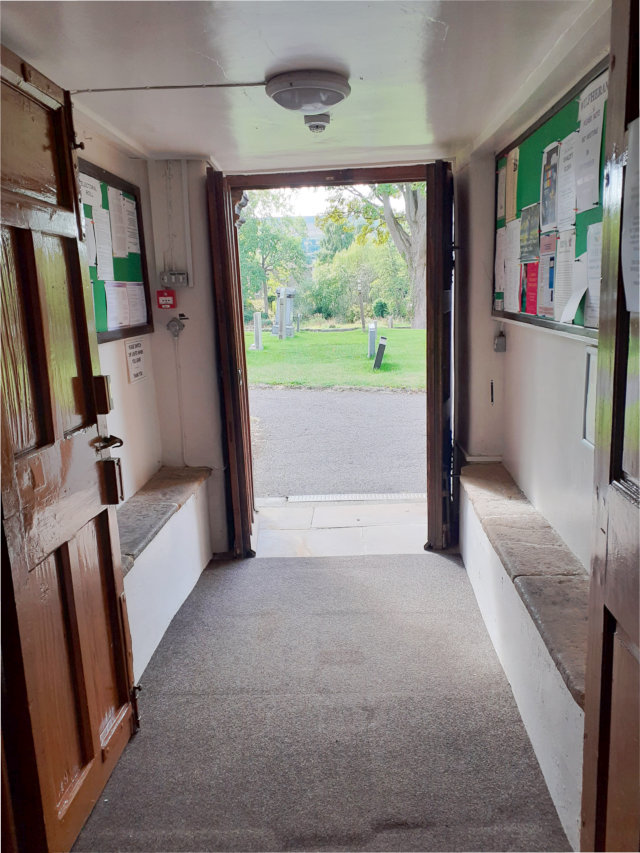
The west tower was built in place of the steeple originally proposed, the date and names of the churchwardens can be seen on a string course above the clock. The gallery at the west end of the church was erected and a ceiling was installed in the nave, hiding the bulk of the oak roof.
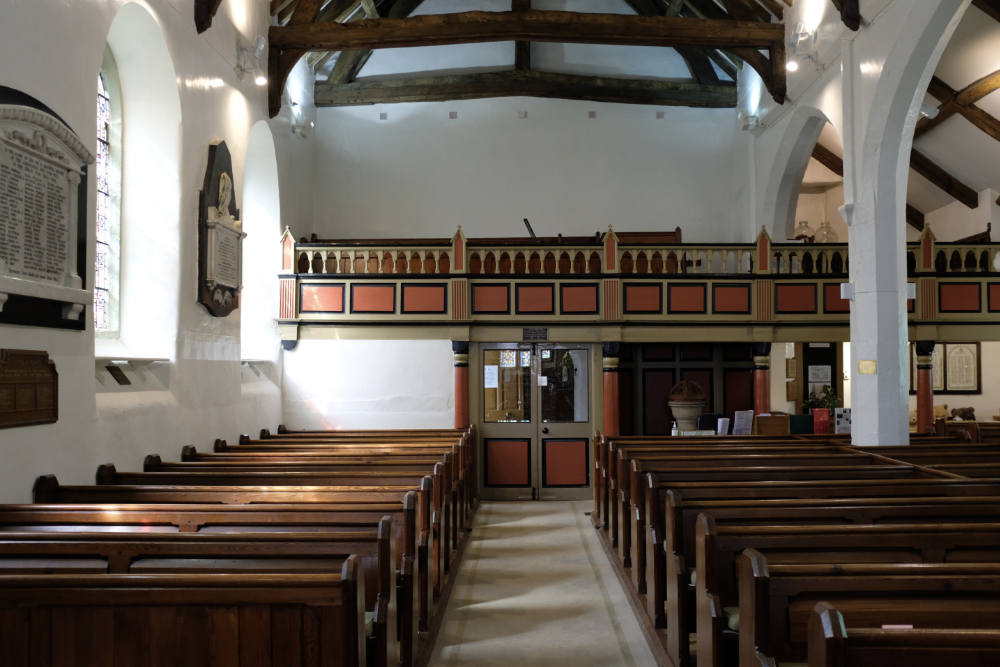
On completion of the tower, a peal of six bells was ordered from Sellers of York, but these failed to come up to specification. After considerable controversy, Lester and Pack of London supplied a new peal in 1759, these being the bells still rung today!
Several documents relating to these building works are held in the archives. These include specifications and accounts and letters relating to the bells. (More information about St Peter’s Bells here.)
Further work took place in 1788 when the old vestry was pulled down and rebuilt.
In 1782 the first William Thompson resigned the living in favour of his 24 year old son, also William Thompson, the patron again being Sir John Ingilby.
In April 1789 the younger William Thompson married, but in November of that year both he and his wife died within two days of each other and were buried on the same day in the same grave. The succeeding Rector, Rev’d. John Coates held the living for 40 years.
John Cunliffe, described in the Parish Registers as maltster, grazier, woolstapler, yeoman and gentleman was the son of Ellis Cunliffe of Ilkley and Addingham, who had married Mary Lister, the daughter of the Vicar of Ilkley. He was a wealthy man who had purchased a lot of land in Addingham and he married Mary, the daughter of the first Revd. William Thompson. The Rector, John Coates, married Mary Cunliffe, the daughter of John Cunliffe, so the incumbency was indirectly retained in the Thompson family. Mary Thompson had inherited, through her grandfather, Revd. William Thompson, the advowson of the church and she became patron of the living which remains in the family to this day.
In addition to his duties in Addingham, Revd. Coates, like William Thompson before him, was Curate at Bolton Abbey for several years.
In 1792, Revd. Coates attempted to have himself elected headmaster of Skipton Grammar School, an episode not to his credit.
19th Century
RECTORS
- 1830 Thomas Brayshaw
- 1840 William Coates Thompson
- 1895 Joseph William Hall
The long incumbency of John Coates saw the Industrial Revolution spread to Addingham with the change from hand to mechanised labour. In 1826, riots took place at Low Mill and the Rector’s brother in law, Ellis Cunliffe who was master at the mill, read the Riot Act and was responsible for calling out the soldiers.
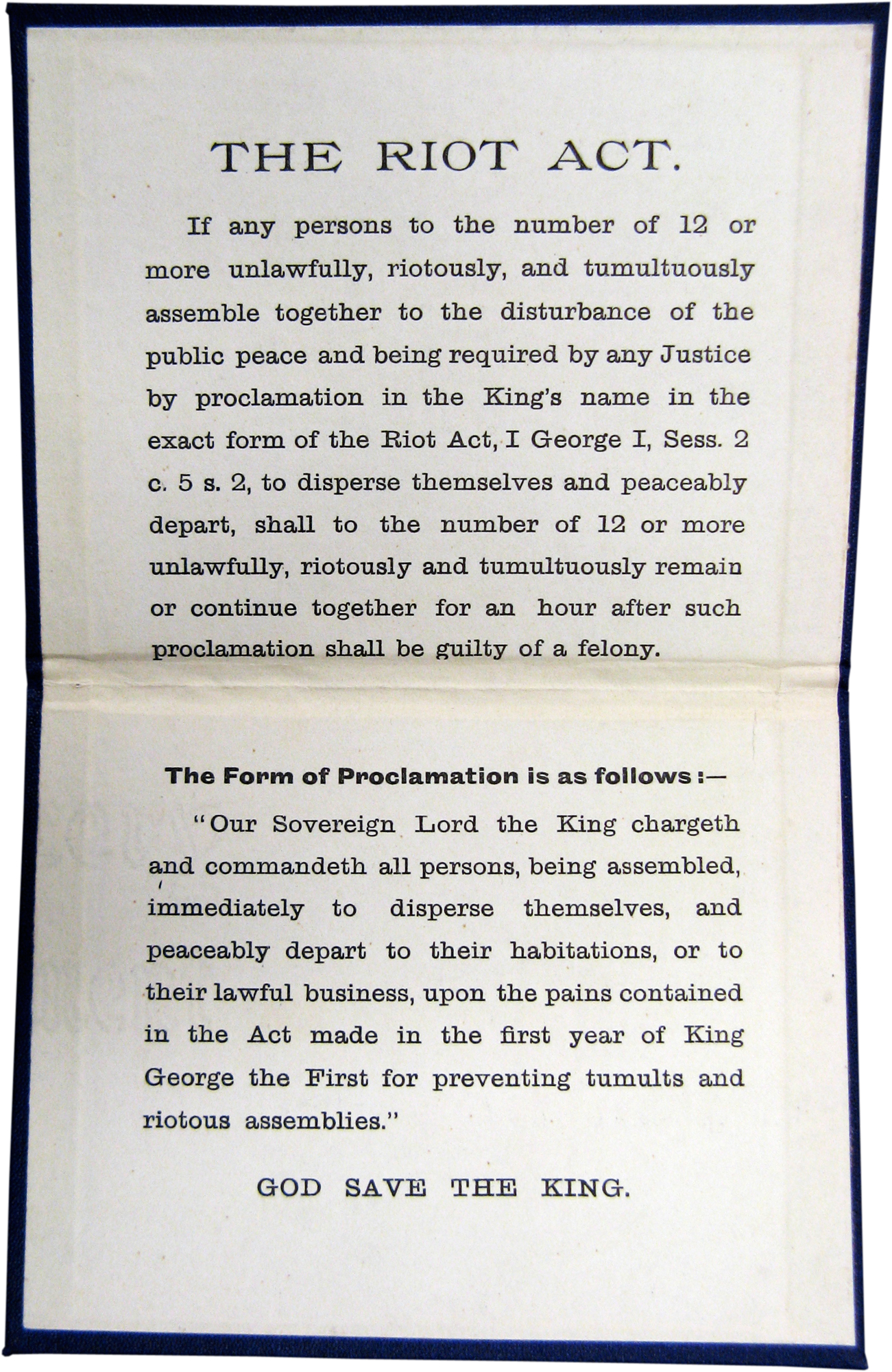
The wording of the Riot Act
Ellis Cunliffe had married the heiress of the Listers of Manningham, Ruth Myers who died in 1796. He then married Mary Kay. He inherited the Lister fortune and changed his name to Cunliffe-Lister. His fourth son, Samuel Cunliffe-Lister, later in the century, invented a mechanised wool combing machine. He prospered and became the first Baron Masham.
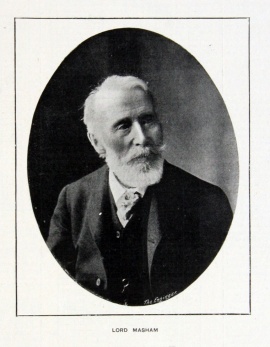
Baron Masham
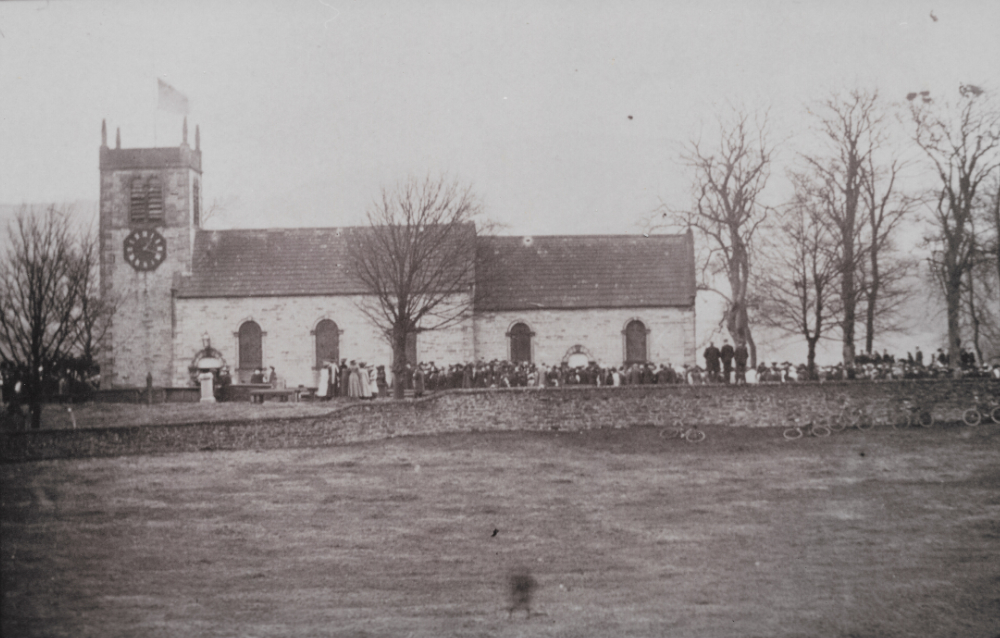
The funeral of Baron Masham at St Peter’s (note the crowds standing in the Churchyard)
John Coates died in 1830 to be followed by Revd. Thomas Brayshaw as Rector. About this time the clock was put into the tower. The clock was made by William Cryer of Carleton near Skipton (More about the clock here). In 1840, Thomas Brayshaw was succeeded by William, the son of John Coates. He had added his grandmother’s name to his own to become William Coates Thompson (the third William Thompson). During his incumbency, in 1858, a good deal of reconstruction took place in the chancel which involved a new roof, a partial rebuilding of the east wall and the insertion of the present east window.
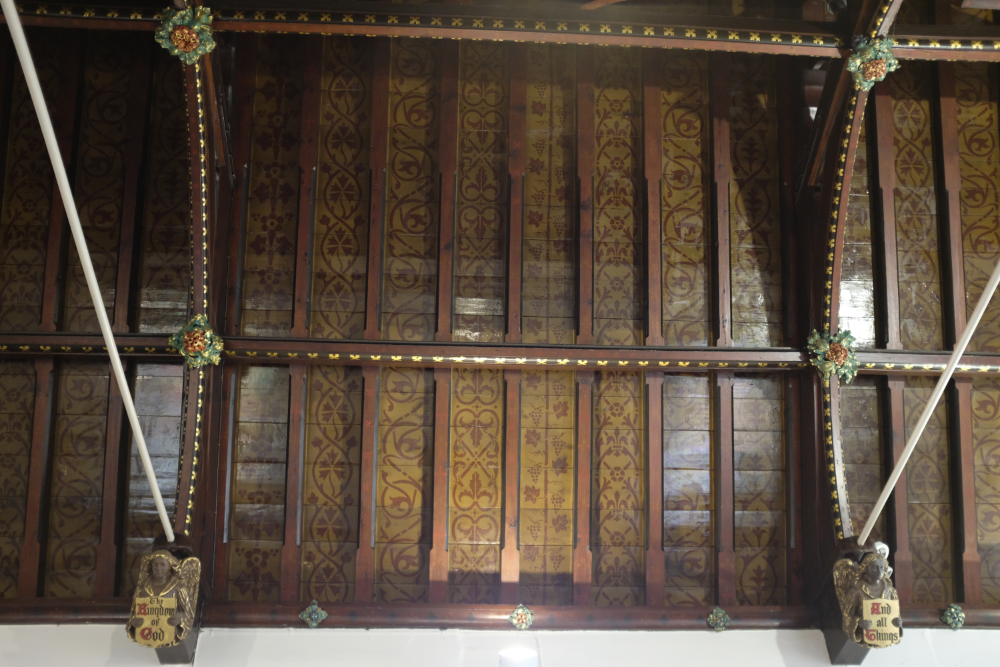
Chancel painted ceiling
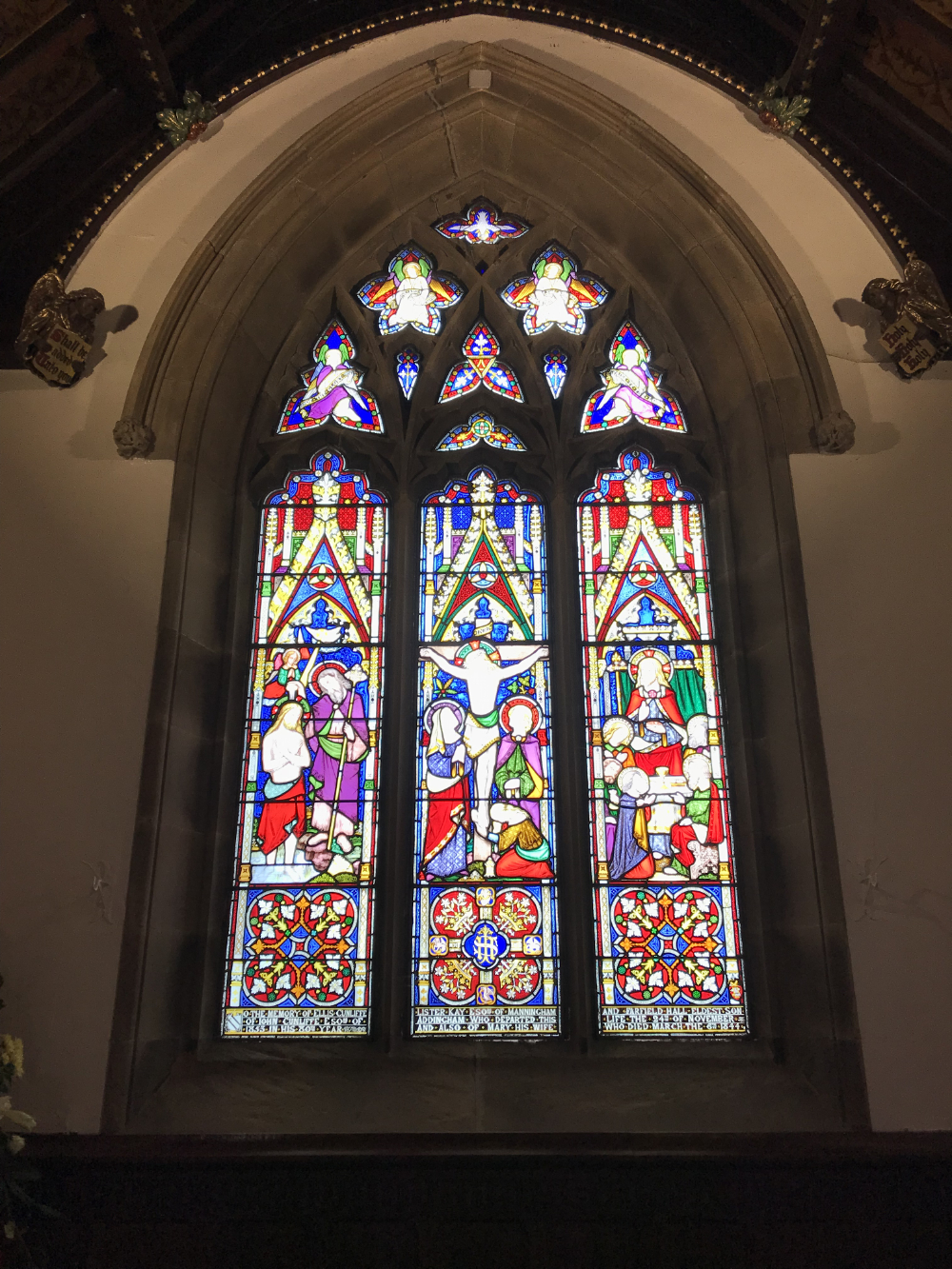
The East Window
In 1861 the organ was installed.

The organ
As well as being Rector, William Coates Thompson was the Squire. He was Rector for 55 years and had several Curates during this time, the last of whom, Joseph William Hall, succeeded him as Rector, continuing until his death in 1930.
20th Century
RECTORS
- 1930 Harold Dudley Blakeney Flynn
- 1947 John Francis Wrangham Hardy
- 1954 Lionel Philip Clare
- 1966 Peter C.G. Billingham
- 1970 Dennis Alfred Arthur Shaw
- 1993 Michael John Casterton
- 1998 Andrew Richard Tawn
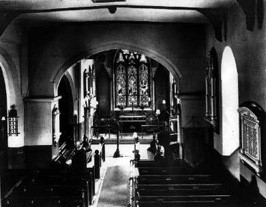
St Peter’s in 1920’s – the oak beamed roof is still covered by a plaster ceiling
The century opened, as it was to continue for most of the first 50 years, with Britain at war. The Boer War had started in 1899 and continued until 1902 to be followed by the First World War in 1914 then in 1939 by the Second World War. The Korean War lasted from 1950 to 1953. Memorials to the Addingham men killed in the two World Wars are on the south wall of the nave. (There is also a Roll of Honour with the names of all servicemen.)
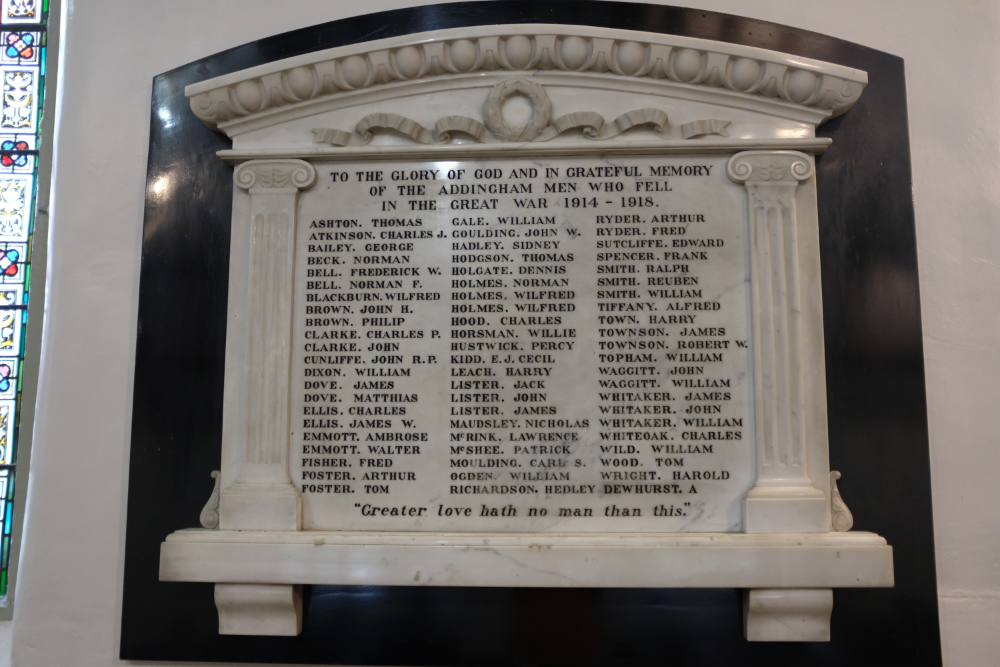
First World War memorial
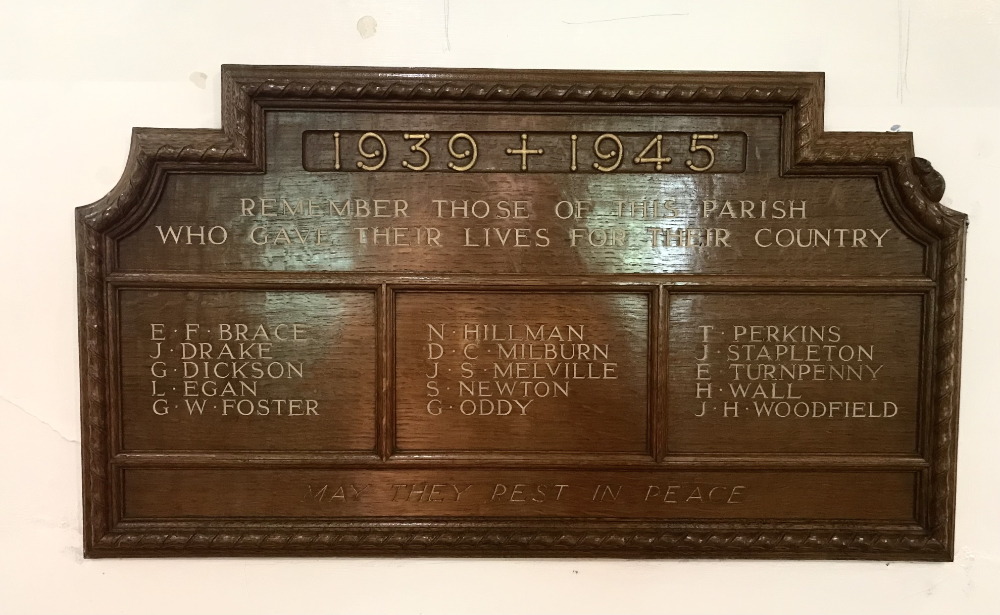
Second World War memorial
The Rector J. Wrangham Hardy had been a frontline chaplain during World War II. When he left Addingham, he gave to the church the cross which he had carried with him throughout his war service; it hangs on the wall above the pulpit, facing the war memorial boards. (Wrangham Hardy later served as Chaplain to HM the Queen from 1962-4, and in 1967.)
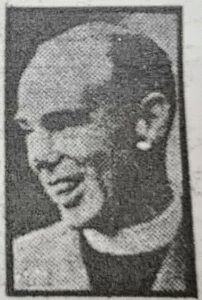
John Francis Wrangham Hardy
In 1947, during the digging of a trench, the shaft of the 9th century stone cross was discovered.
Between 1949 and 1952, various works and renovations were carried out. First, new altar rails and new choir stalls were installed in the church. These were made by the famous “mouseman”, Thompson of Kilburn. The altar rails were dedicated on 23rd September 1949.
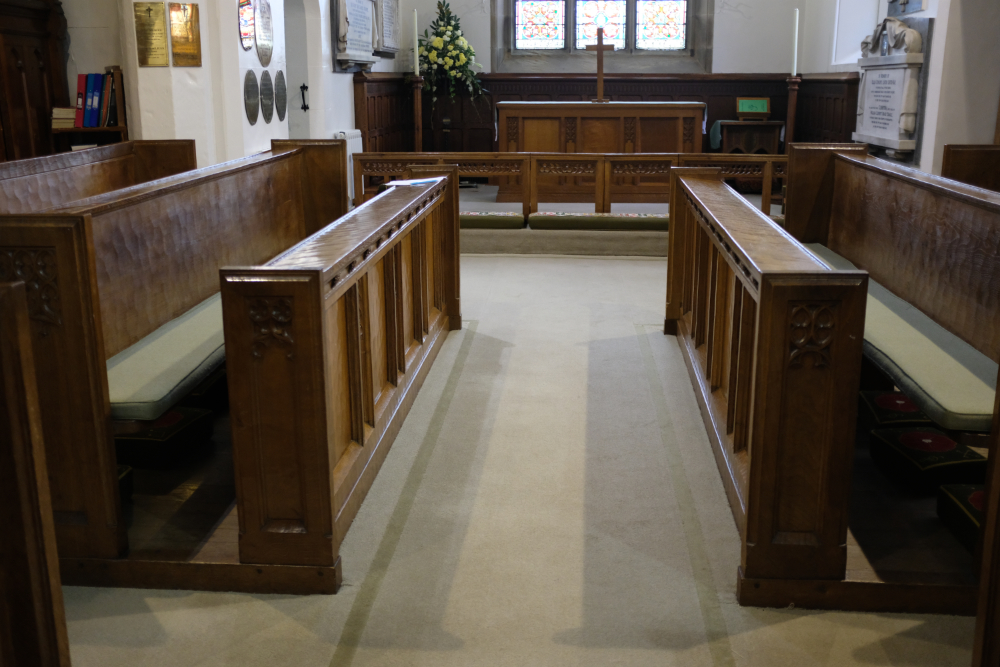
Altar rails and choir stalls
Over the years, the roof of the church had deteriorated to such an extent that in 1952 it had to be completely replaced. It was during the re-roofing that the Tudor oak roof was rediscovered – the first time it had been seen for 200 years – and the 18th century ceiling was removed. Finally, the church was redecorated.
June 1953 saw the Coronation of Queen Elizabeth II and a special Divine Service took place at St Peter’s.
A small church hall was built in the church field during the incumbency of Revd. Peter Billingham.
Around this time, the church began to think about bringing itself into the modern world and after a long process, begun in 1946, the New English Bible, printed in the language of the present day, was published in 1961. Various modern versions of services were then introduced culminating in the Alternative Service Book, the first new Prayer Book since 1661.
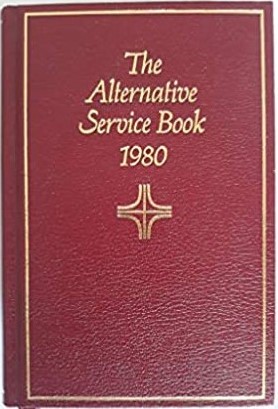
The Alternative Service Book, 1980
Revd. Dennis Shaw, who came to Addingham in 1969 and was to be Rector of St Peter’s for the next 23 years, ensured that we used this new Prayer Book from the first Sunday that it became legal, in 1980. It was he gave us our first motto as a result:
“The Ancient Church with the Modern Prayer Book”.
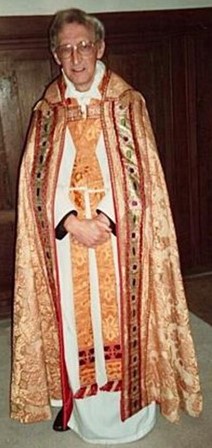

Revd. Dennis Shaw
His leadership saw the founding of Friends of St Peter’s Addingham (FOSPA) who have been serving tea and homemade cakes every summer weekend since that time, and of the Wulfherans (named after the Anglo Saxon bishop Wulfhere), an adult mixed fellowship holding monthly meetings open to all. The Rector led a large youth group as part of his ministry here, as well as overseeing much improvement to the church building and the churchyard. During his time the large old Rectory adjacent to the church was sold and a new Rectory purchased just across the road.
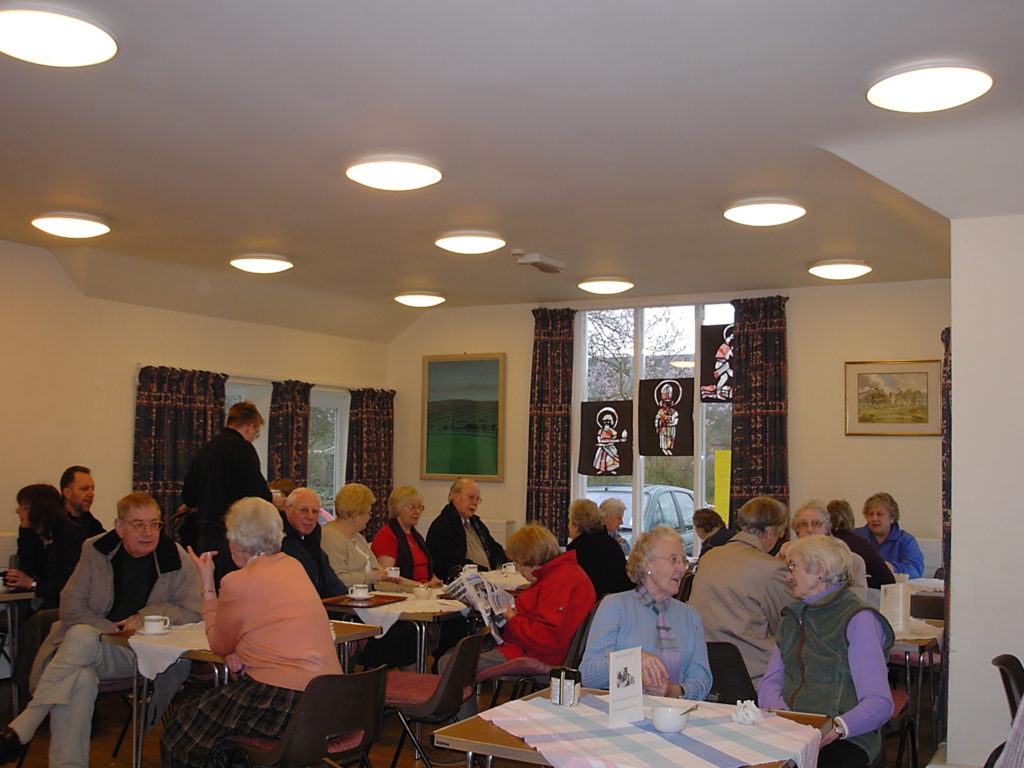
FOSPA teas
In the early 1970’s an Iron Age ditch which encircles the church was excavated, and a carved bone fragment (possibly a comb case) dating from the Viking age was found.
From 1983, our Patron at St Peter’s has been John Thompson-Ashby, whose family have had the responsibility of the patronage of this church since 1745. We are fortunate to have such a dedicated Patron who takes an active interest in the life of the church and visits regularly.
In 1990, excavations took place to the west of the church hall in preparaton for the proposed hall extension. The dig revealed an 8th century graveyard, which was at least a hundred years earlier than the arrival of Wulfhere. About fifty graves were discovered containing the remains of eighty people of all ages, men, women and children.
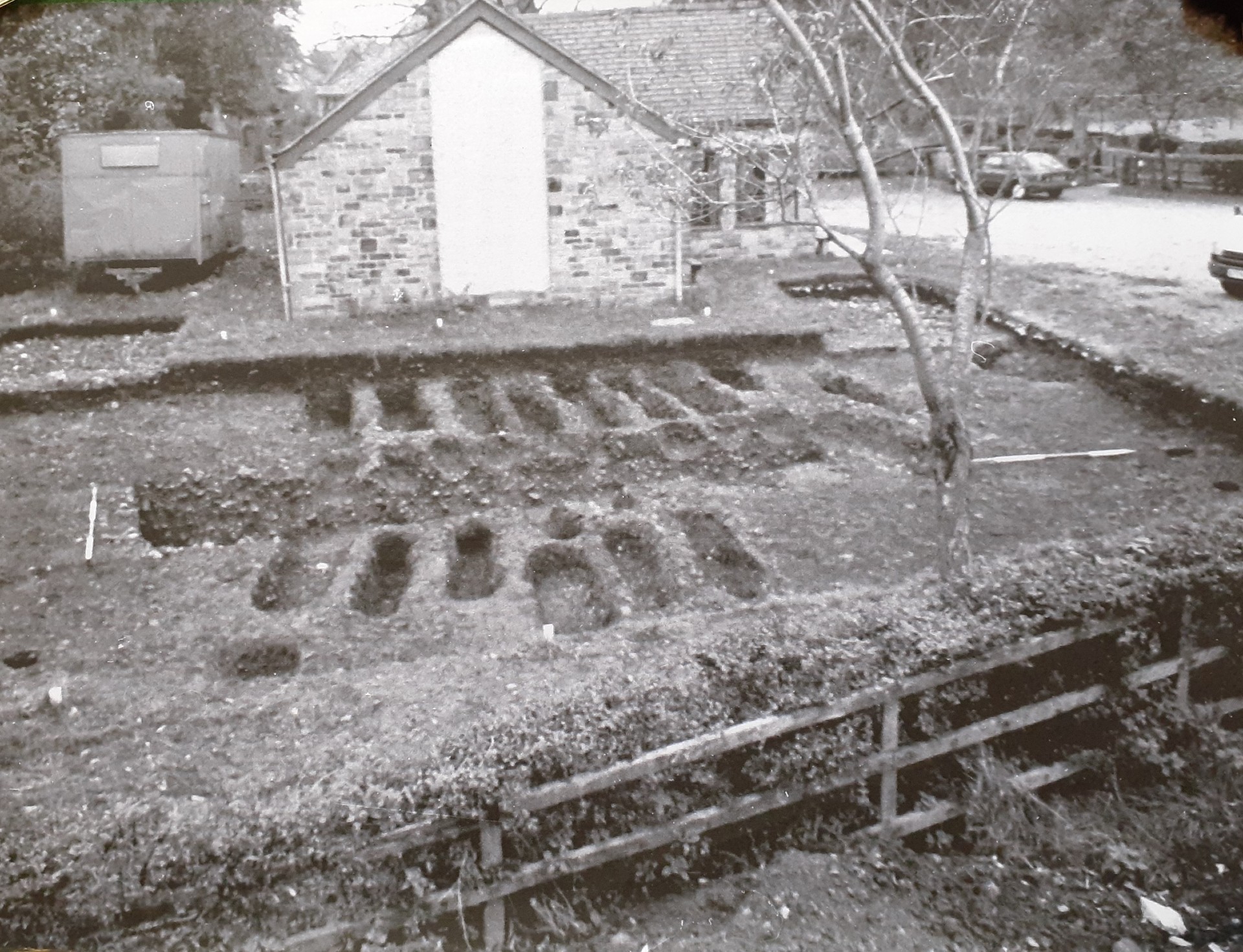
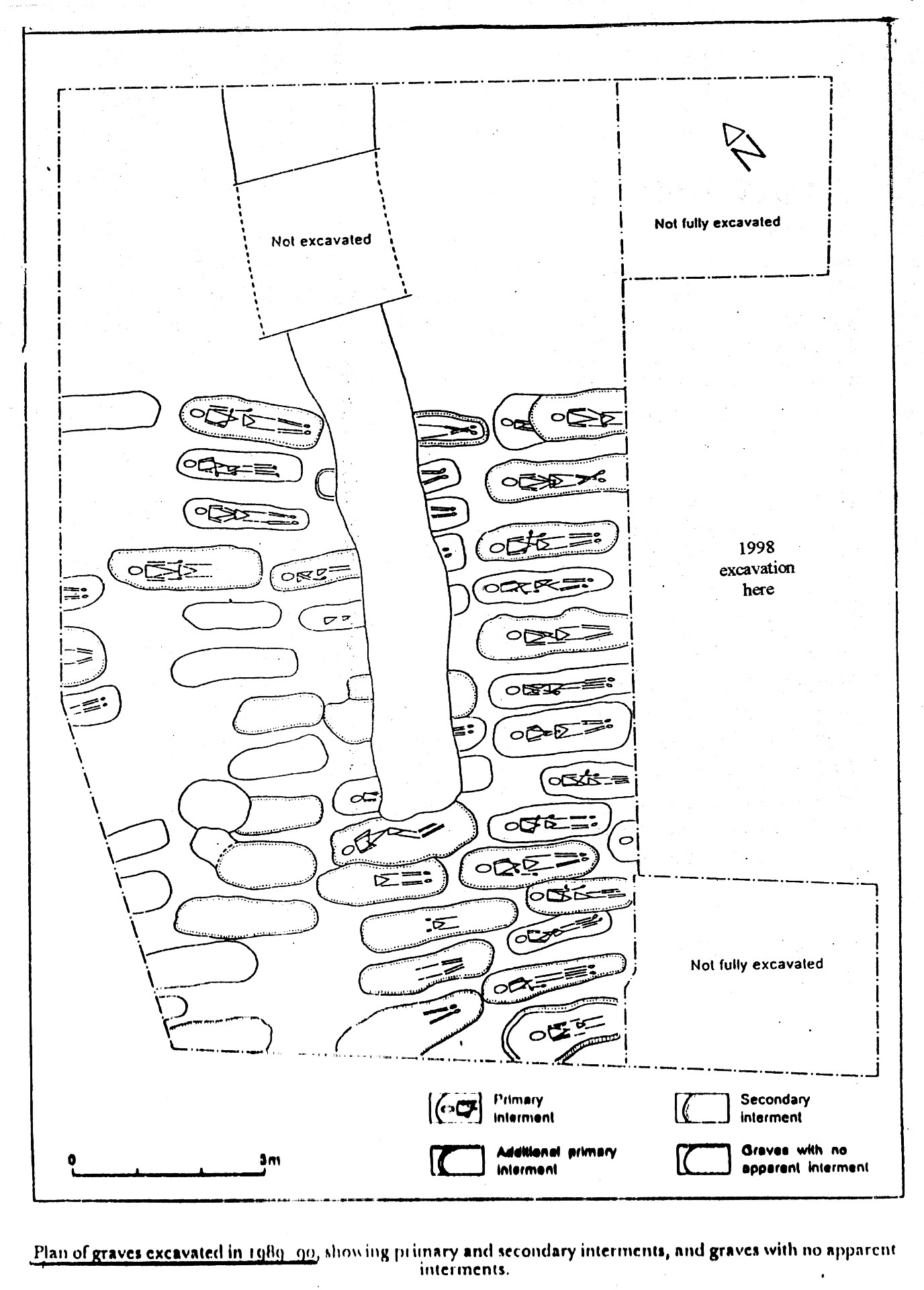
8th century graves discovered in the archeological dig in 1990
After Revd. Dennis Shaw retired in 1992, Revd. Michael Casterton was appointed Rector.
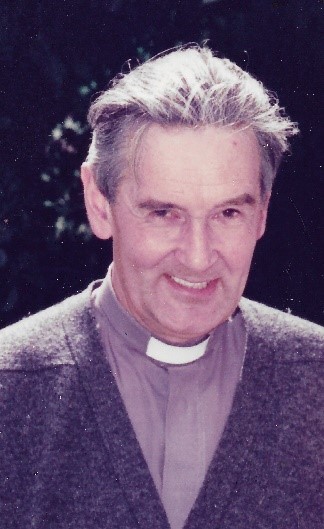
Revd. Michael Casterton
He was a keen musician with a particular love of the organ. He introduced the Healing service at St Peter’s. It was during his incumbency that the project to replace all the kneelers was begun. Sadly, Michael died suddenly in August 1997 and never saw the end of the project. The new kneelers are a great asset to the beauty of our church.
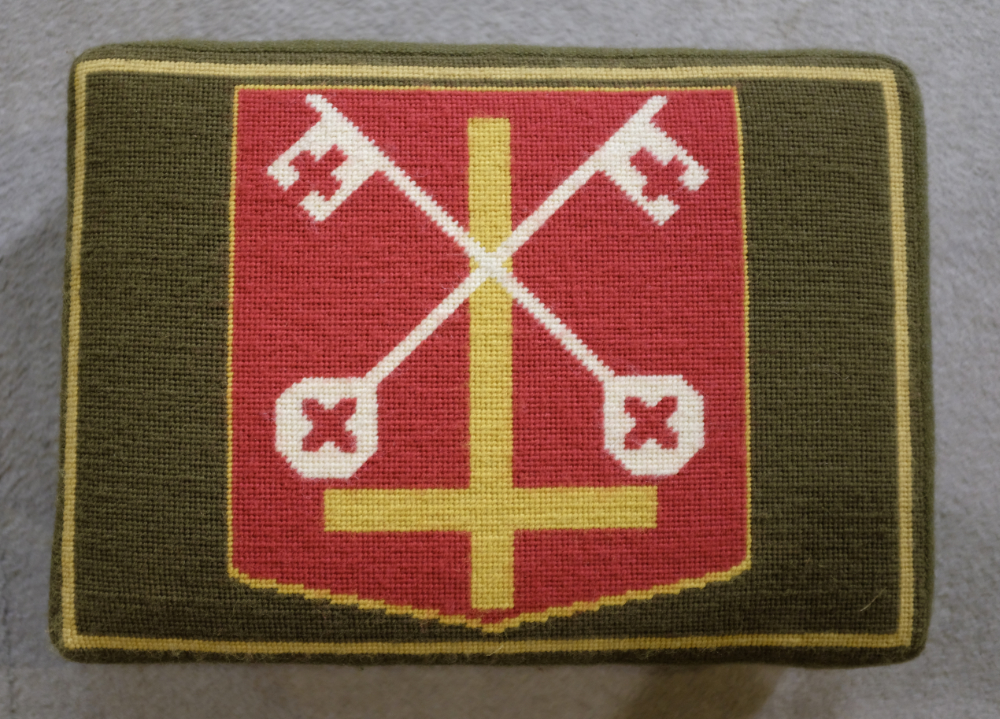
Kneeler
May 1998 saw the Induction of Rector, Revd. Andrew Tawn.
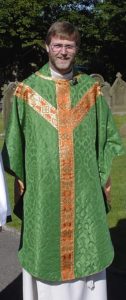
Revd. Andrew Tawn
21st Century
RECTORS
- 2013 Jill Perrett
- 2020 Mark H Cannon
In the incumbency of Revd. Andrew Tawn, we finally saw the completion, after about 20 years, of the Church Hall Extension which was dedicated on 22nd January 2000 by the Bishop of Bradford, the Right Reverend David Smith.
St Peter’s was chosen to be part of a Diocesan pilot scheme to introduce young people to communion before confirmation, and the children’s voices, prayers and dedication are a joy and a challenge in our worship and in the life of the church.
In 2001, the Information Area at the back of church, with lending library, notice boards, prayer book and Book of Remembrance, was completed and dedicated after many years of planning.
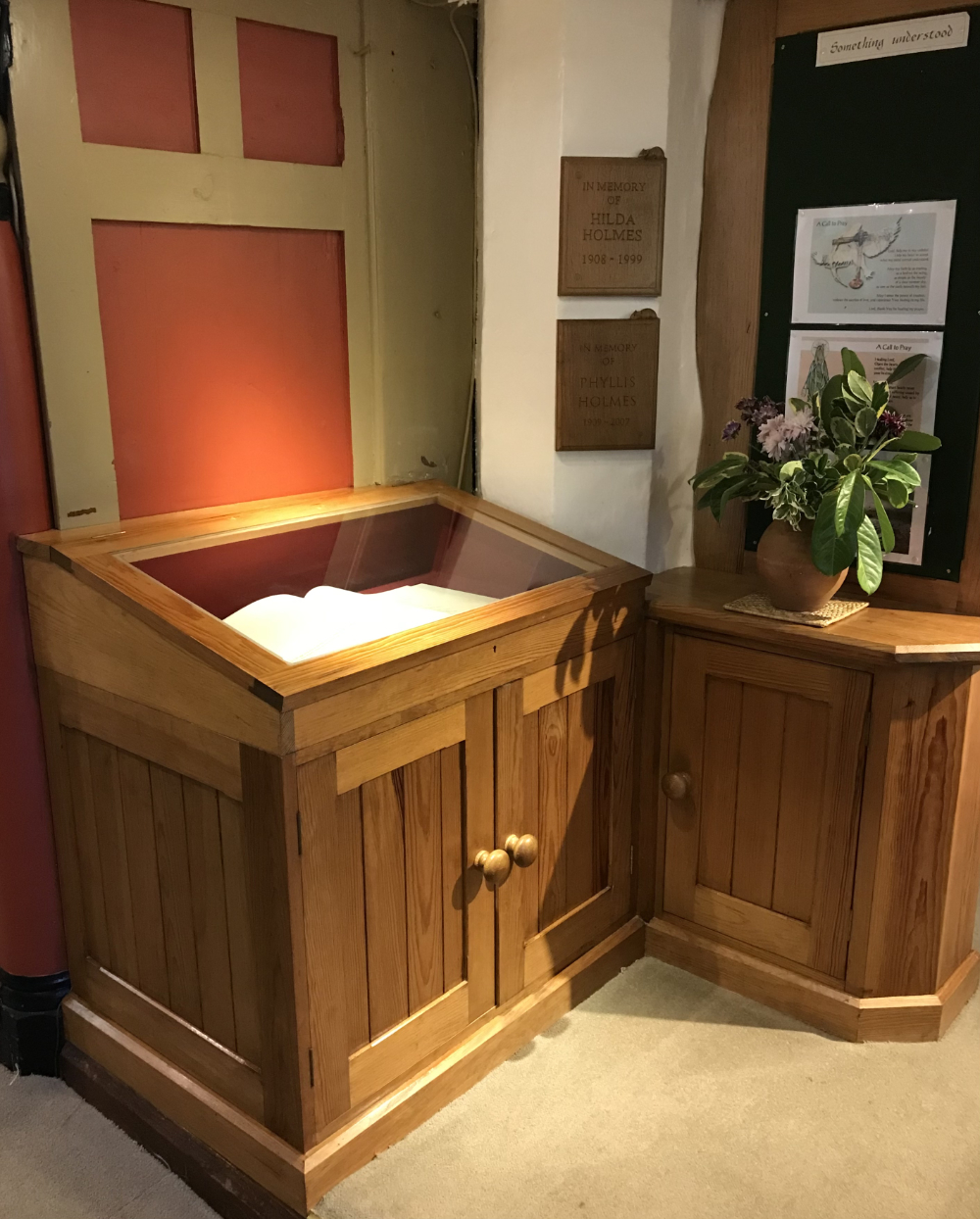
Memorial Book
In 2002 the organ was restored and enlarged, in memory of the Rev. Michael Casterton, with funding by Friends of St Peter’s Addingham (FOSPA) and parishioners. (More information about the organ here.)
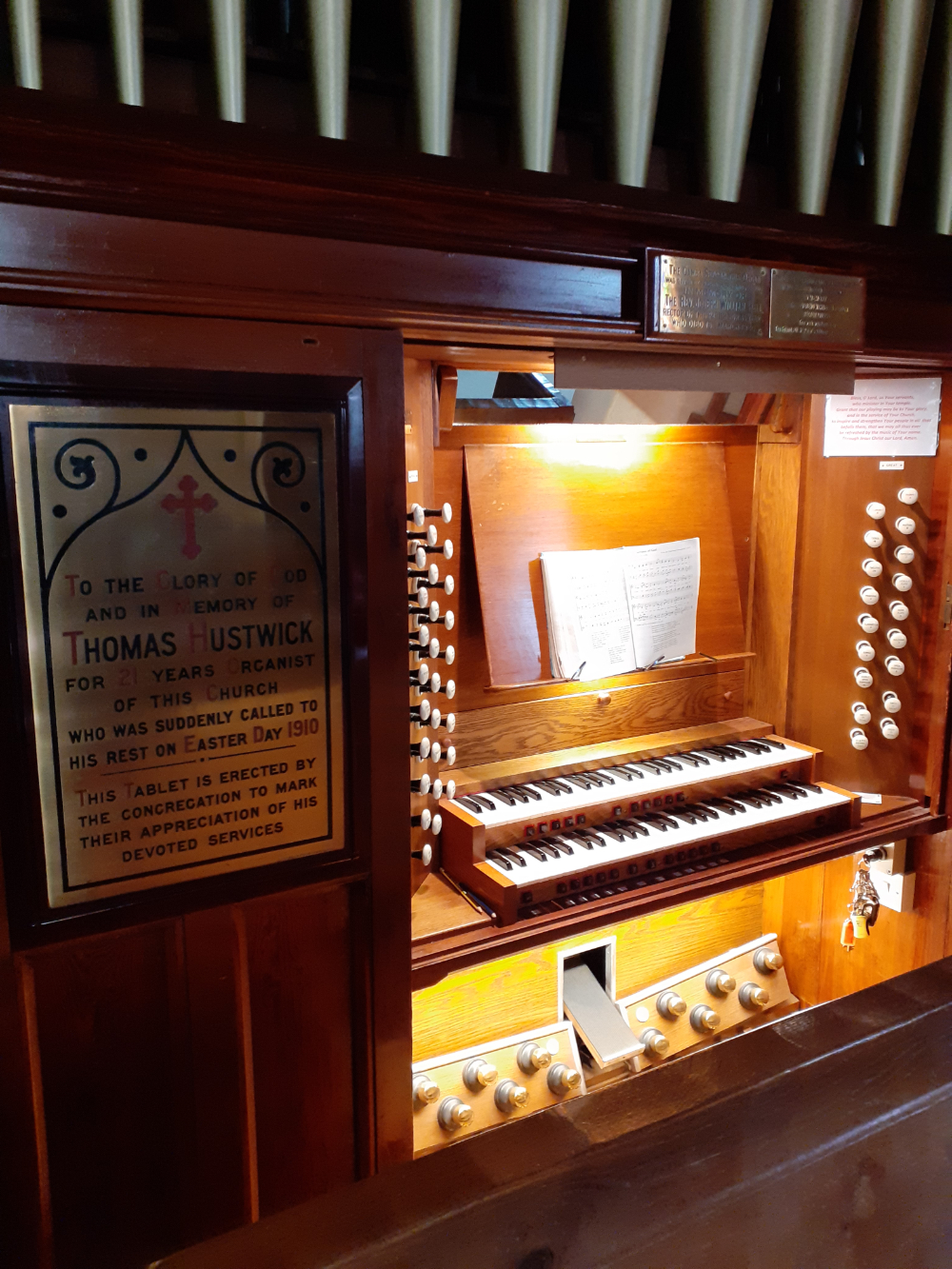
The organ console after the restoration and enlargement
2003 started with a visit, on January 1st., from our new Bishop, David James, calling in at St Peter’s for prayers and tea on his walking pilgrimage on the way to his service of welcome at the Cathedral. In February there was an inaugural recital for the organ. A new floor was built in the Ringing Chamber in the Tower, funded by FOSPA, which makes rope-handling easier for the bell ringers.
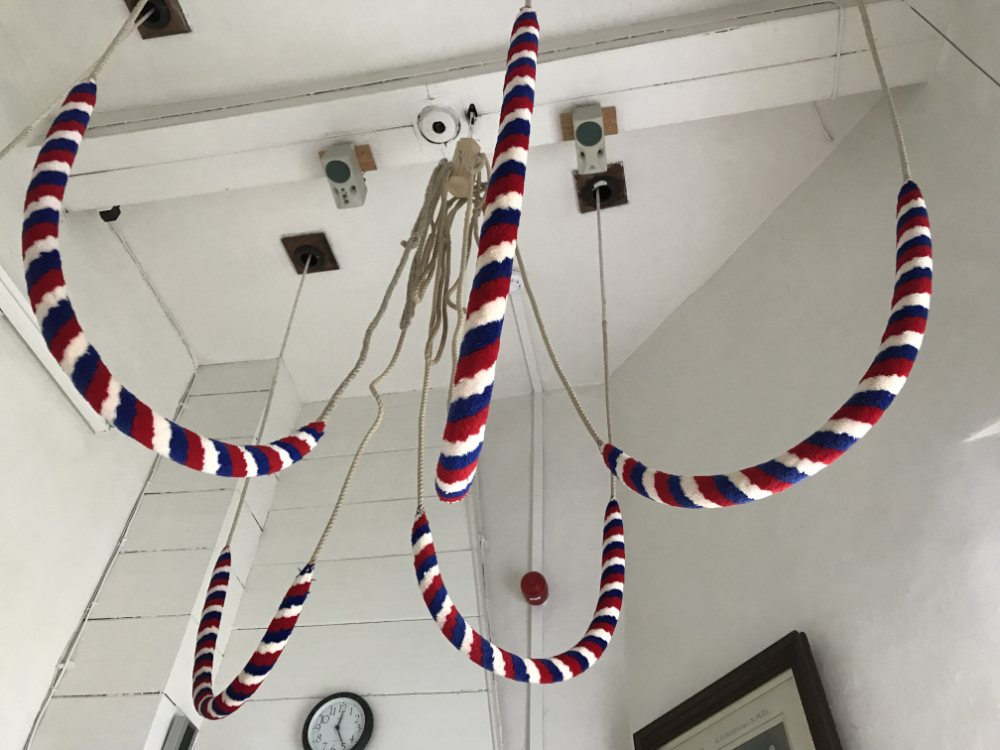
The ringing chamber
Morning Prayer was said each week at St Peter’s on Tuesday, Wednesday, Thursday and Friday.
In 2004 there were more confirmations, the Jigsaw group was started for teenagers (jointly with the Methodist Church), with a new group called Bats in the Belfry on alternate Sunday mornings. Our annual Discussion Day was entitled ’Being part of a growing church’. ‘What’s the Story’ taught us a lot about characters in the Bible. In 2005, Bishop David led our discussion day, more people were confirmed, and two of our congregation were accepted to be trained for the ministry. Our children enjoyed the special thought-provoking sessions of ‘Godly Play’ on Sundays. We were saddened by the untimely loss of our Reader and friend Gil Davies, whose memory enriches our life at St Peter’s.
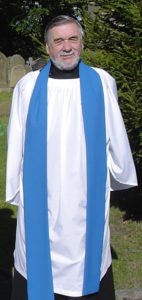
Gilmoure Davies
2006 was the 25th anniversary of FOSPA teas (welcoming one and all each summer Sunday afternoon for a cup of tea, and a walk in our beautiful grounds), and Paul Summers became our assistant Priest.
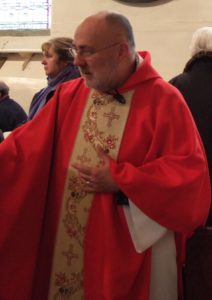
Revd Paul Summers
In 2007, two members of our congregation were ordained:
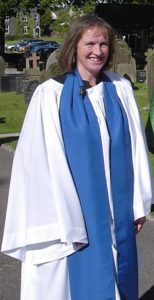
Revd. Louse Taylor Kenyon (when Reader at St Peter’s)
Louise served initially in Skipton (and now in Northumbria), and we were delighted that Barbara was our Curate at St Peter’s working alongside Andrew and Paul.
We began a Lottery-funded project explore and celebrate the Christian heritage of Addingham, which included services, workshops, a village church trail, dendro-dating of the church roof beams and a further excavation of the Anglo Saxon Christian burial ground at St Peter’s, which revealed more 8th century graves. (More details here.)
2008 saw Barbara’s priesting.
Revd Barbara Clarke
Our Christian heritage project continued with a raft of activities including a ‘historic music’ cd, information leaflets and a wonderful ‘strolling play’ about the history of the church from its earliest times to now. The Bishop blessed the memorial carvings, set into the wall of the extended hall, commemorating the burials of our Anglo Saxon ancestors and celebrating the beauty of the site and our Christian faith. (More details here.)
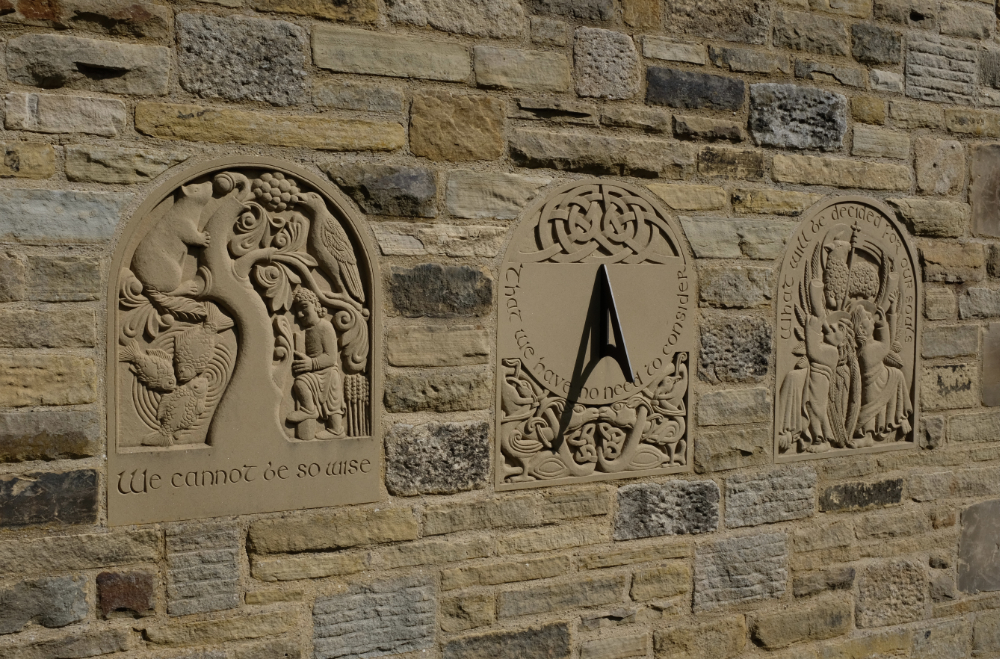
The Memorial carvings are inscribed with a text adapted from the Venerable Bede: “We cannot be so wise that we have no need to consider what will be decided for our souls”.
We were saddened by bereavements and gladdened to worship with friends old and new.
An accidental fire destroyed the hall roof, but no-one was hurt, and much was salvaged. Events during the rest of the year took place in the Church and in premises kindly shared by friends.
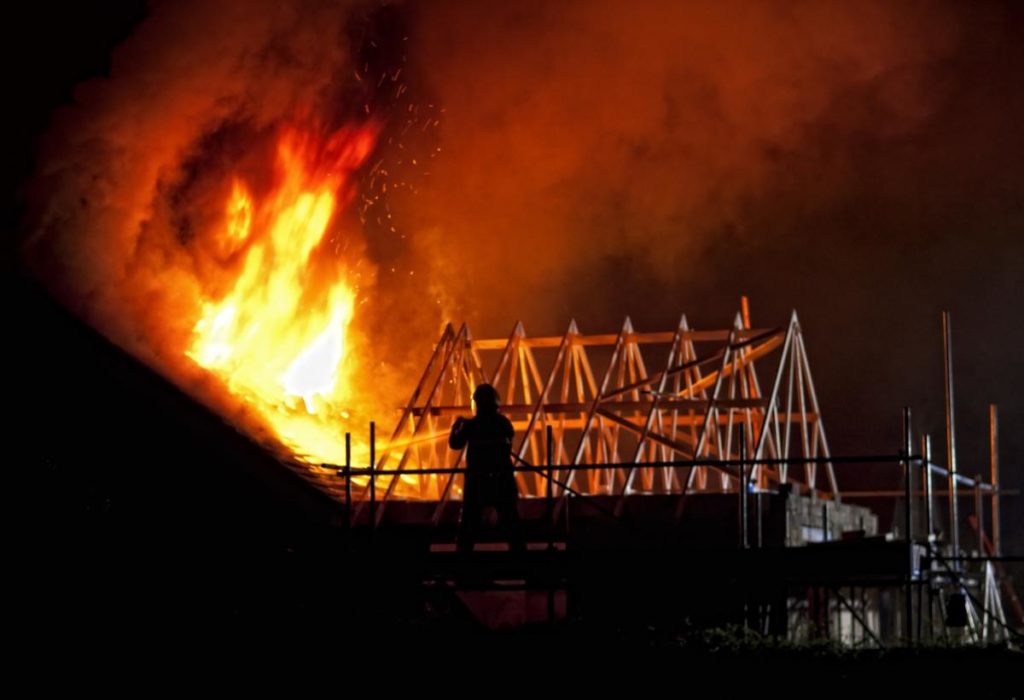
Fire-fighters tackle the hall blaze
The hall was re-opened in Spring 2009. During this year, the Methodist Minister Revd Arnold Clay shared in leading the Wednesday morning Holy Communion services at St Peter’s.
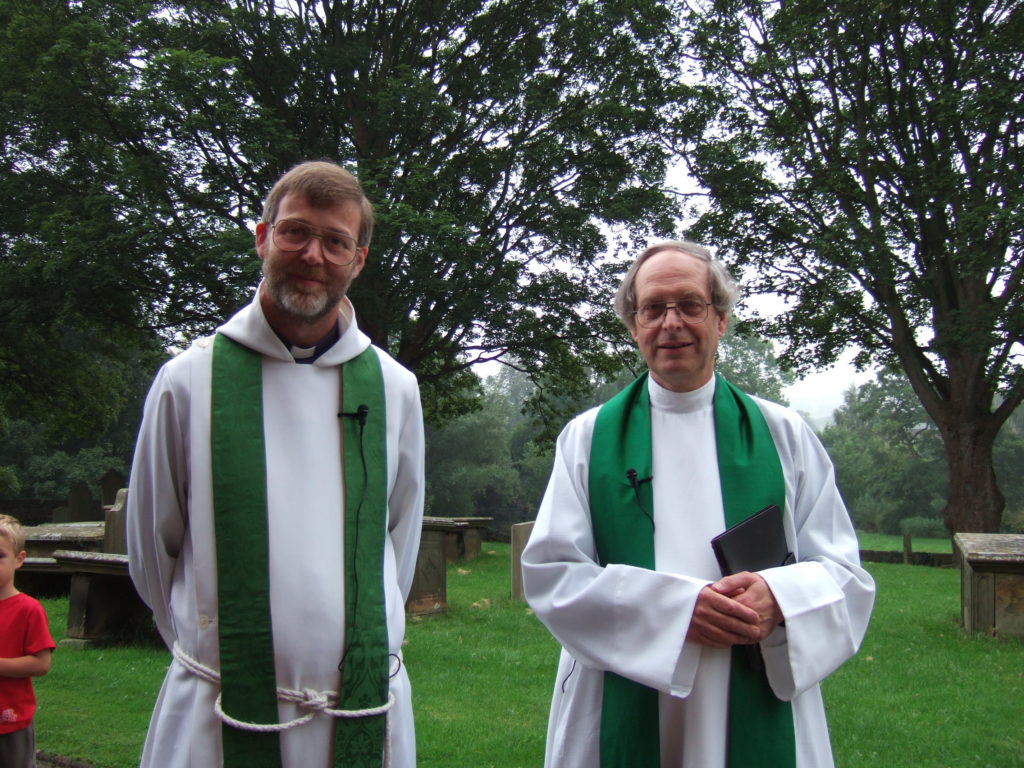
Revd Andrew Tawn with Revd Arnold Clay at St Peter’s
Children met in Hands-On Church, Bats in the Belfry, Junior Church, LEAF (Learning Everything About Faith) and Junior Choir and assisted at Communion on the first Sunday each month.
In 2011 we celebrated 30 years of FOSPA teas.
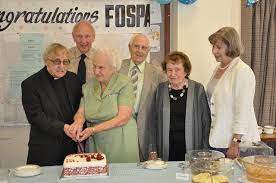
The people who started FOSPA reunite at St Peter’s for the 30th Anniversary: Revd Dennis Shaw, Colin Clarkson, Phyllis Robinson, Derek Robinson, Eileen Shaw and Barbara Clarkson
The Revd. Andrew Tawn left St Peter’s in 2012 and the following year (2013) Ian WIddowson was ordained as Deacon to Christ Church, Skipton.
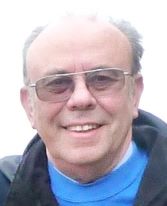
Revd Ian Widdowson
Revd Jill Perrett became our new Rector, the first female incumbent at St Peter’s.
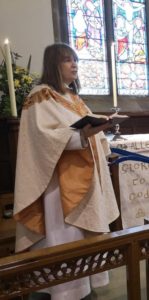
Revd Jill Perrett
Different groups were set up to look at the varied areas of church mission. Like her predecessor, Jill’s post with us was part time. In 2013, an outbreak of dry rot was treated in the church and in 2014, a grass labyrinth was laid out in the top field; walking the pathway provides a time for reflection, meditation and prayer. (More about the Labyrinth here.)
Volunteers from the National Association of Decorative and Fine Arts Societies (NADFAS) spent much time and effort at St Peter’s producing a comprehensive record of its contents.
In this period the church was saddened by the deaths of many beloved members, including in 2019 our Assistant Priest Revd. Paul Summers. Revd. Jill Perrett moved from St Peter’s in 2019.
During the subsequent interregnum, the pandemic of Covid struck, bringing lockdown and completely changing our church life. The Churchwardens quickly took on even more responsibility than normal, on top of their incumbency duties, and in a very short time we were upheld by recorded online worship from St Peter’s, weekly encouraging emails, telephone dial in and postal contacts for those without the internet, and the pastoral team worked hard to keep in touch with the most vulnerable members.
In the midst of Covid, we were cheered by the appointment of Revd. Mark Cannon as our new Rector in 2020.
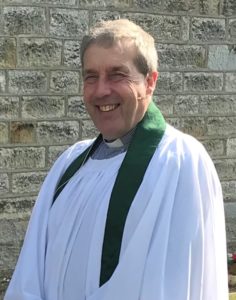
He faced the challenge of getting to know his new church at a time of strict pandemic restrictions, along with being a part-time post. Gradually worship re-started in church, first with spaced booked seating, no singing and in masks, but as safety allowed, a cautious return to more spontaneous gathering took place, plus the welcome return of FOSPA teas.
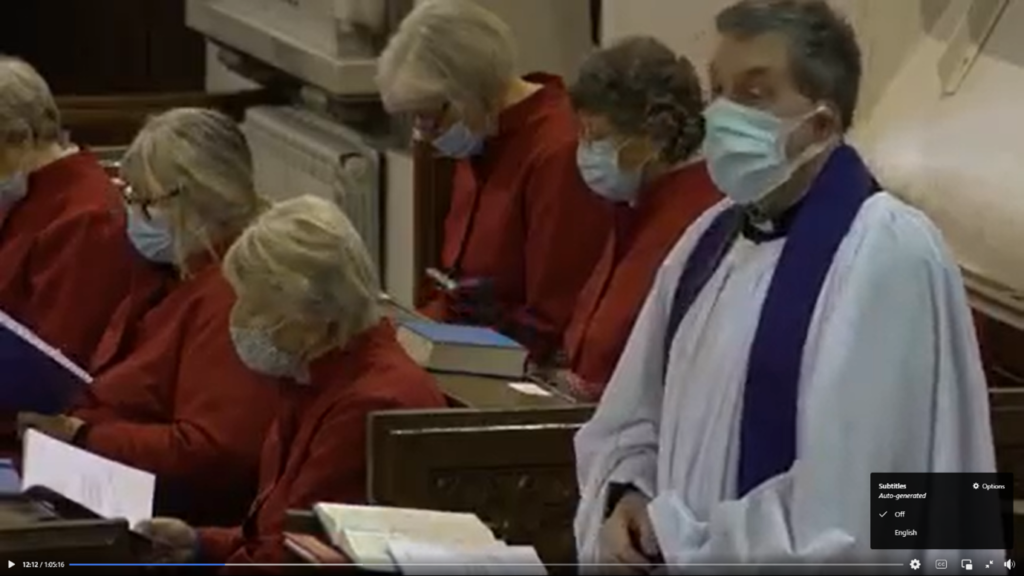
The Rector and Choir members in covid masks, image from livestreamed service
In 2021, Mark prompted the church to conduct a major survey of village opinion about the church, the results of which have shaped church action and outreach.

The Survey, 2021
A more informal monthly morning service and monthly use of the Book of Common Prayer at 8am were both introduced, alongside traditional communion and Evensong services and the return of the monthly Healing service. Livestreaming of services to Facebook received increasing viewers, plus the addition of monthly podcasts on faith topics.
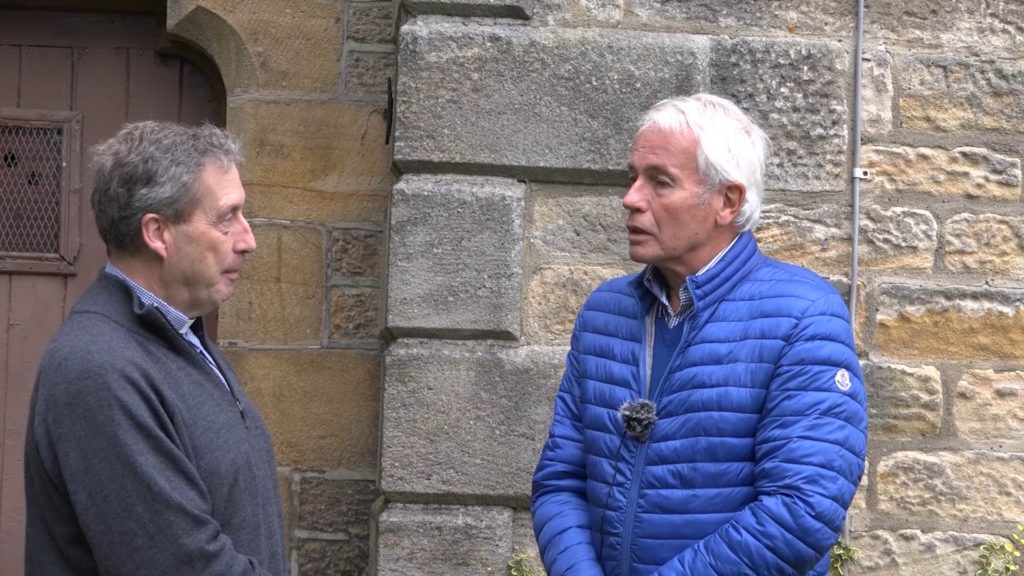
Mark and Ian Hepworth talk during one of the podcasts
A popular Messy Church was established, and Tamsin Carr was appointed in 2022 as Children and Family worker.
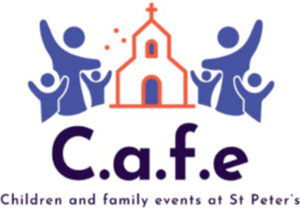
Celebrations for the Queen’s Platinum Jubilee included a Jubilee Peal rung on the Bells of St Peter’s, sadly to be followed shortly by muffled bells marking the the Queen’s death.
A music group was formed to lead singing at the monthly informal service, and in 2025 a Children’s Church started to meet each Sunday alongside the morning service. 2025 also saw Tom Simkiss accepted for ordination, he and Jessie will be in our prayers as he starts his training for the priesthood.

Tom has been accepted to train for the priesthood
We continue to keep in touch with members no longer able to attend church in person since Covid, and have been glad to welcome many new members.
St Peter’s is a thriving, lively modern church, solidly built on its ancient traditions, and we look forward with confidence to the next 1000 years.
We add to these pages as we discover more about the history of the site and the people (and as we make history!), so do keep having a look!
Thanks to the late Peter Simmons for original historical research, text and some illustrations, with acknowledgements to:
the late Kate Mason, the late William Lemmon, Judy Worsnop, the late Muriel Lloyd, Revd. Andrew Tawn, Phyllis Robinson, the late David Smith, York Minster Library and Archives, The Historical Research Centre, Royal Armouries Museum, children from Junior Church and John Holdsworth; and to the late Margaret Kitching for typing.

